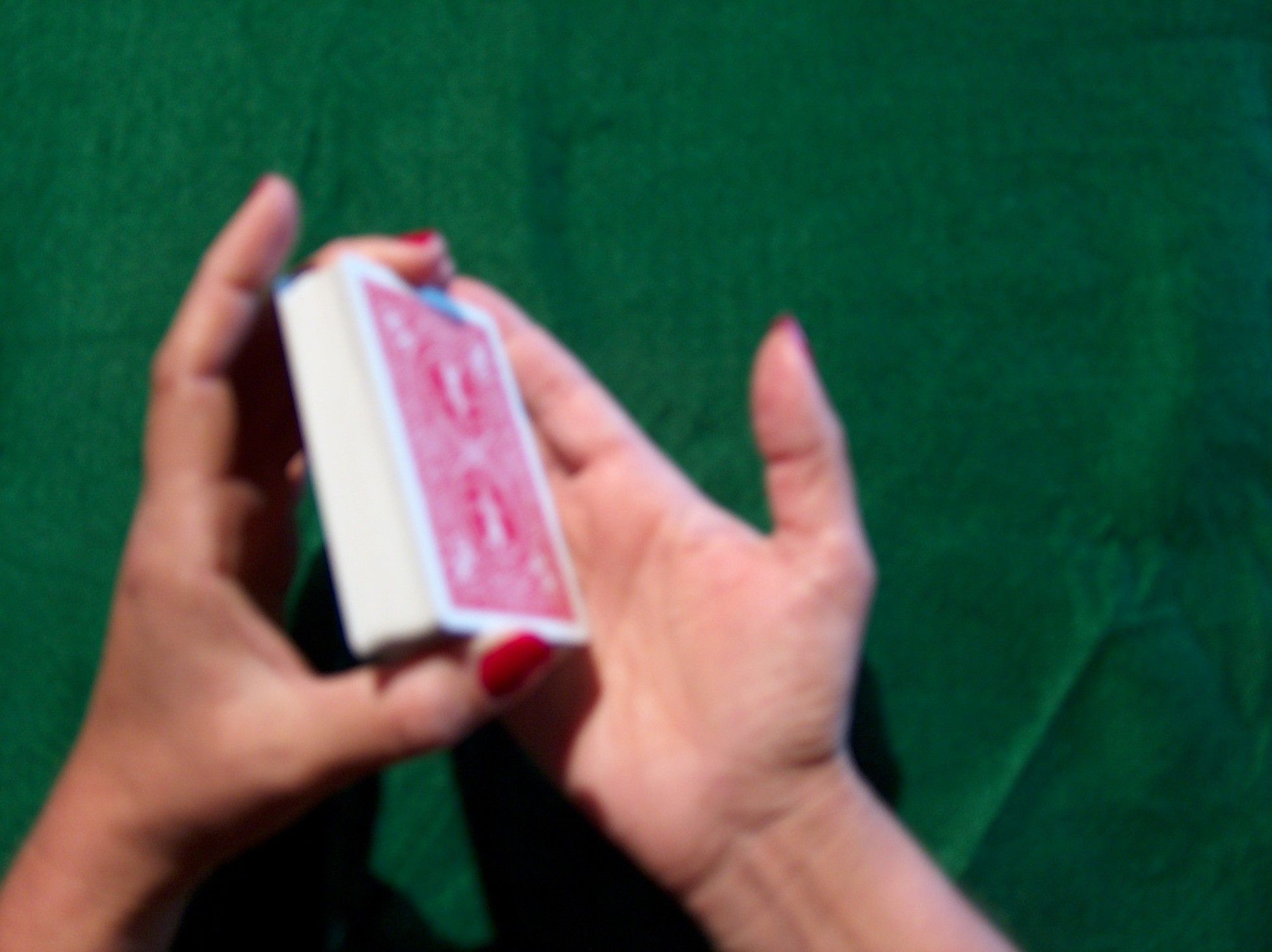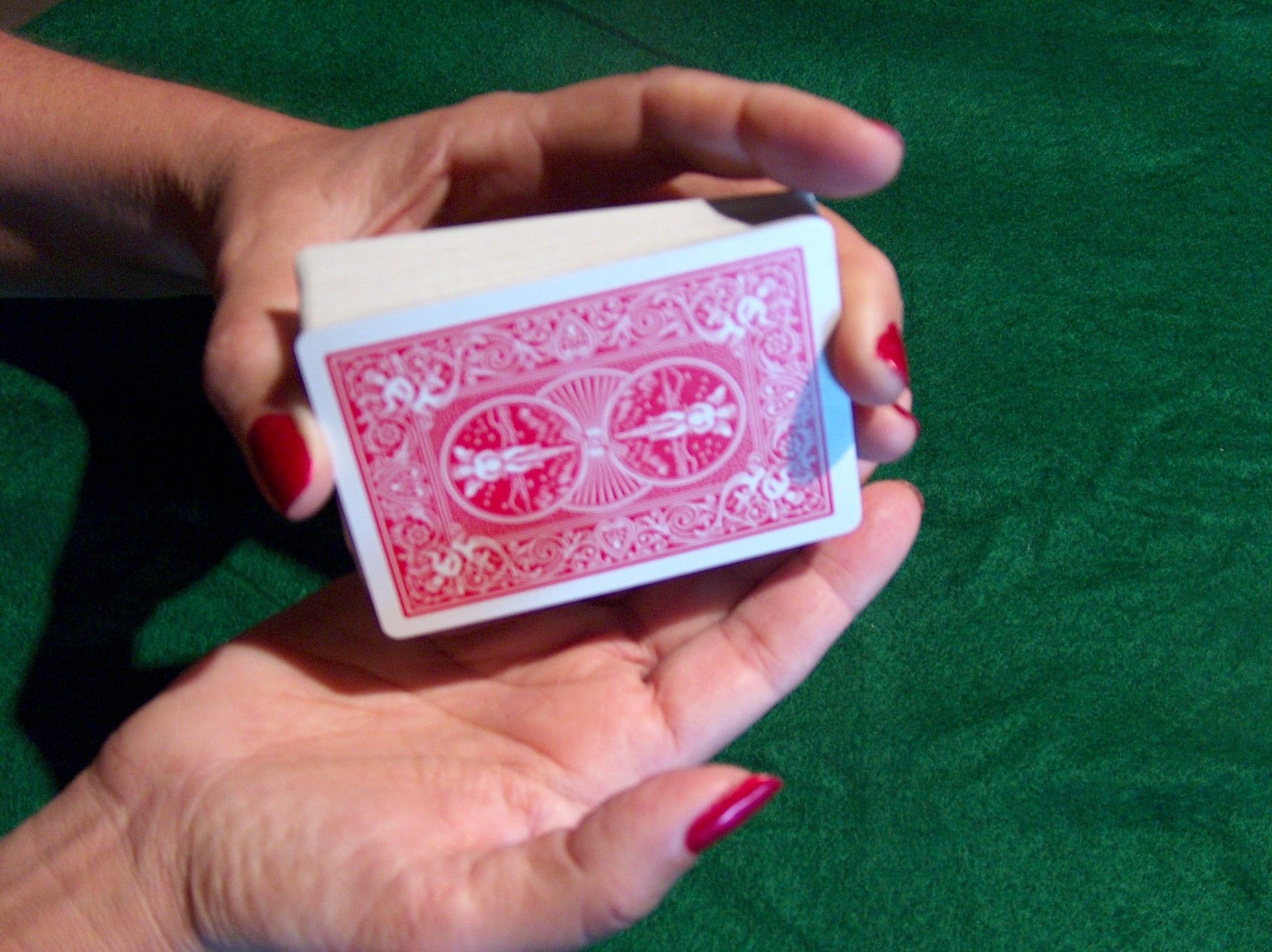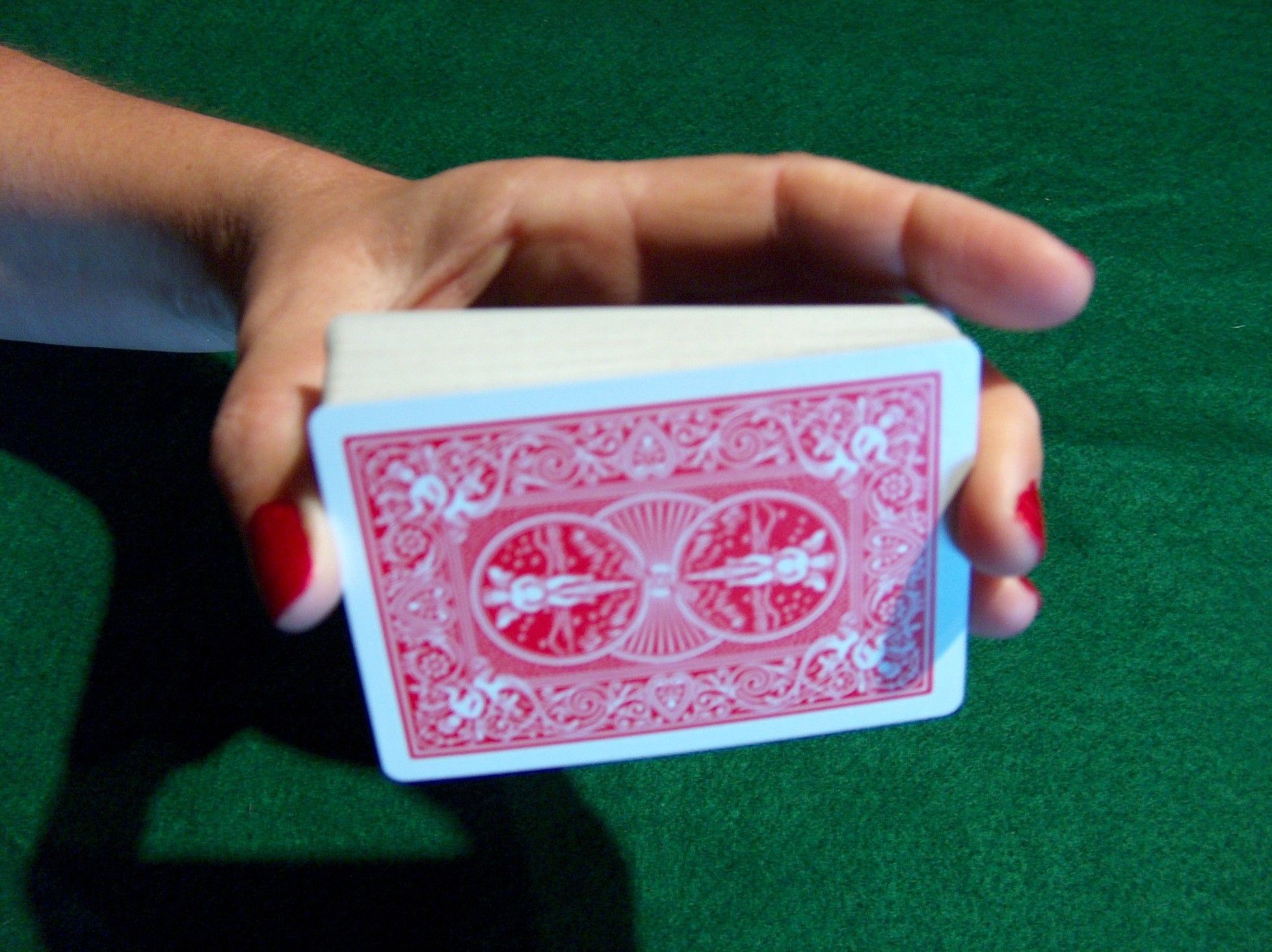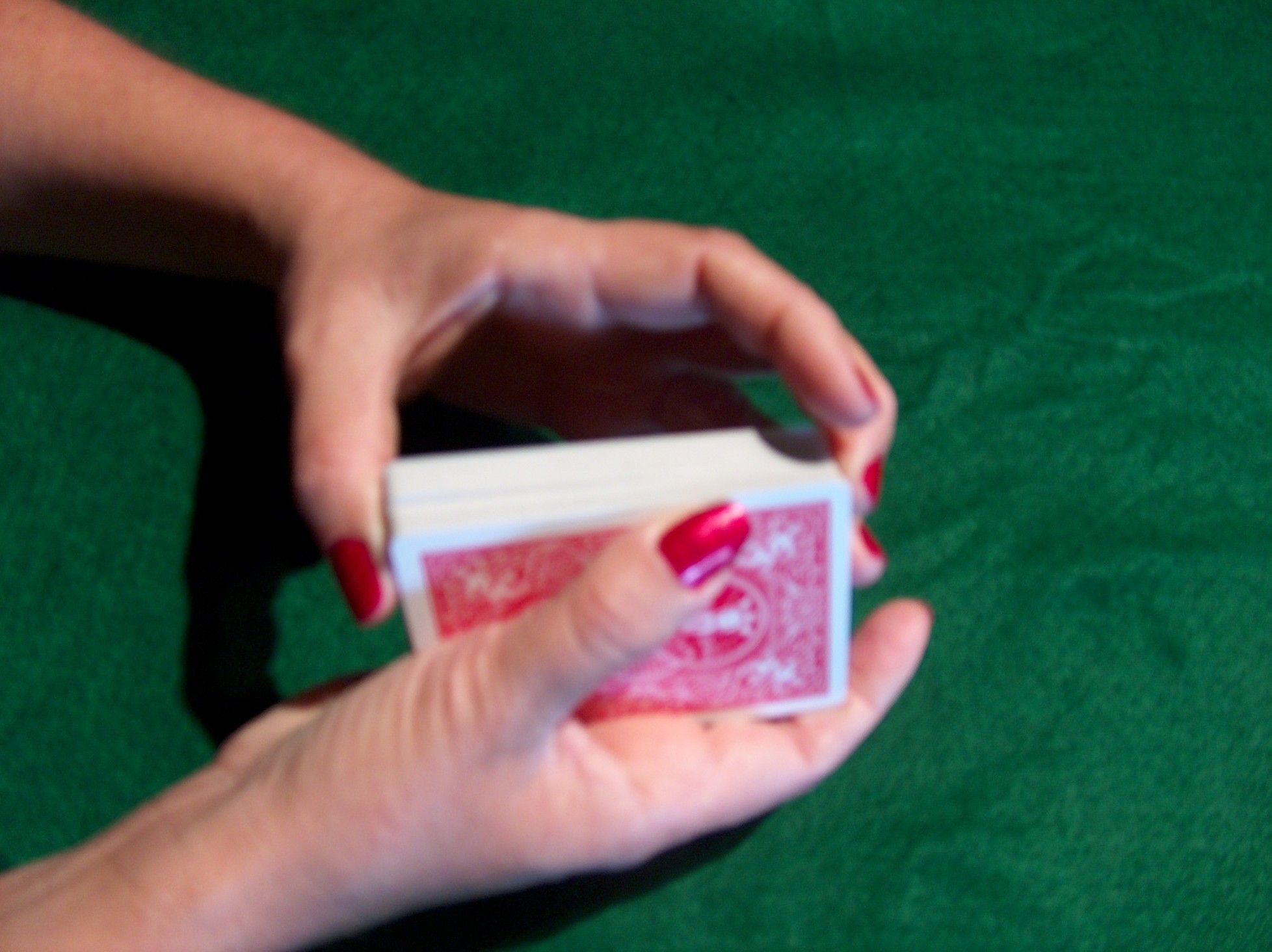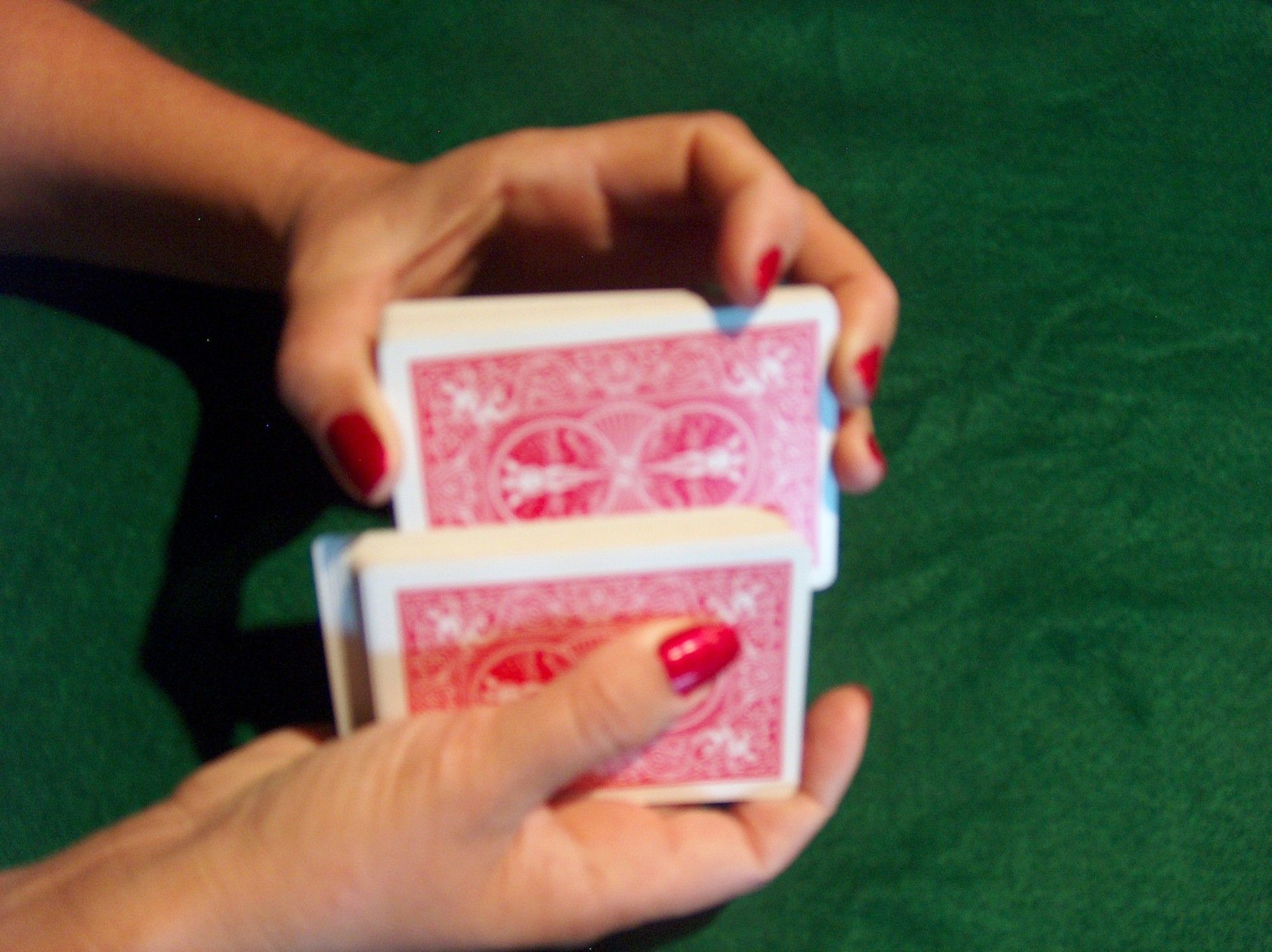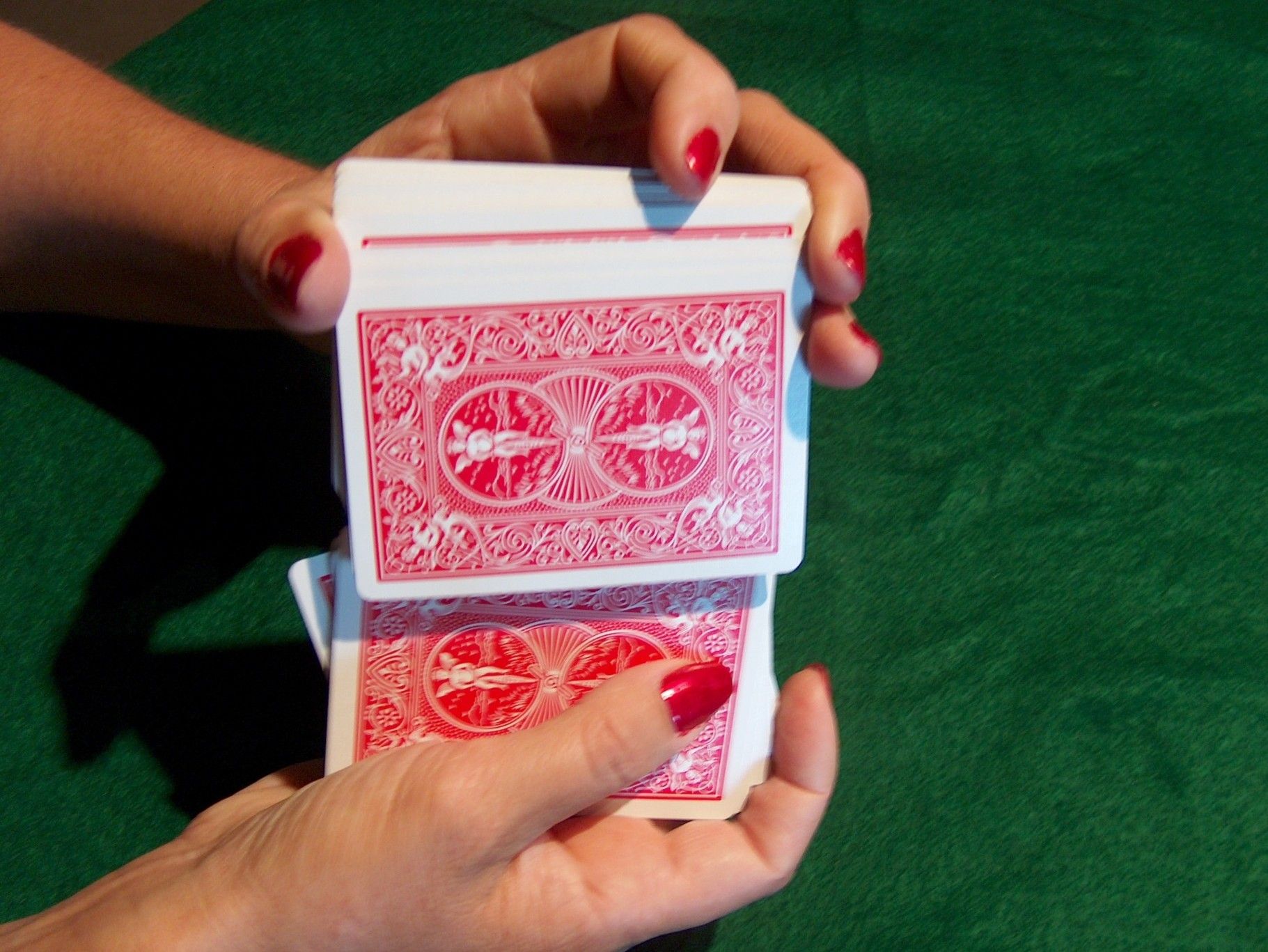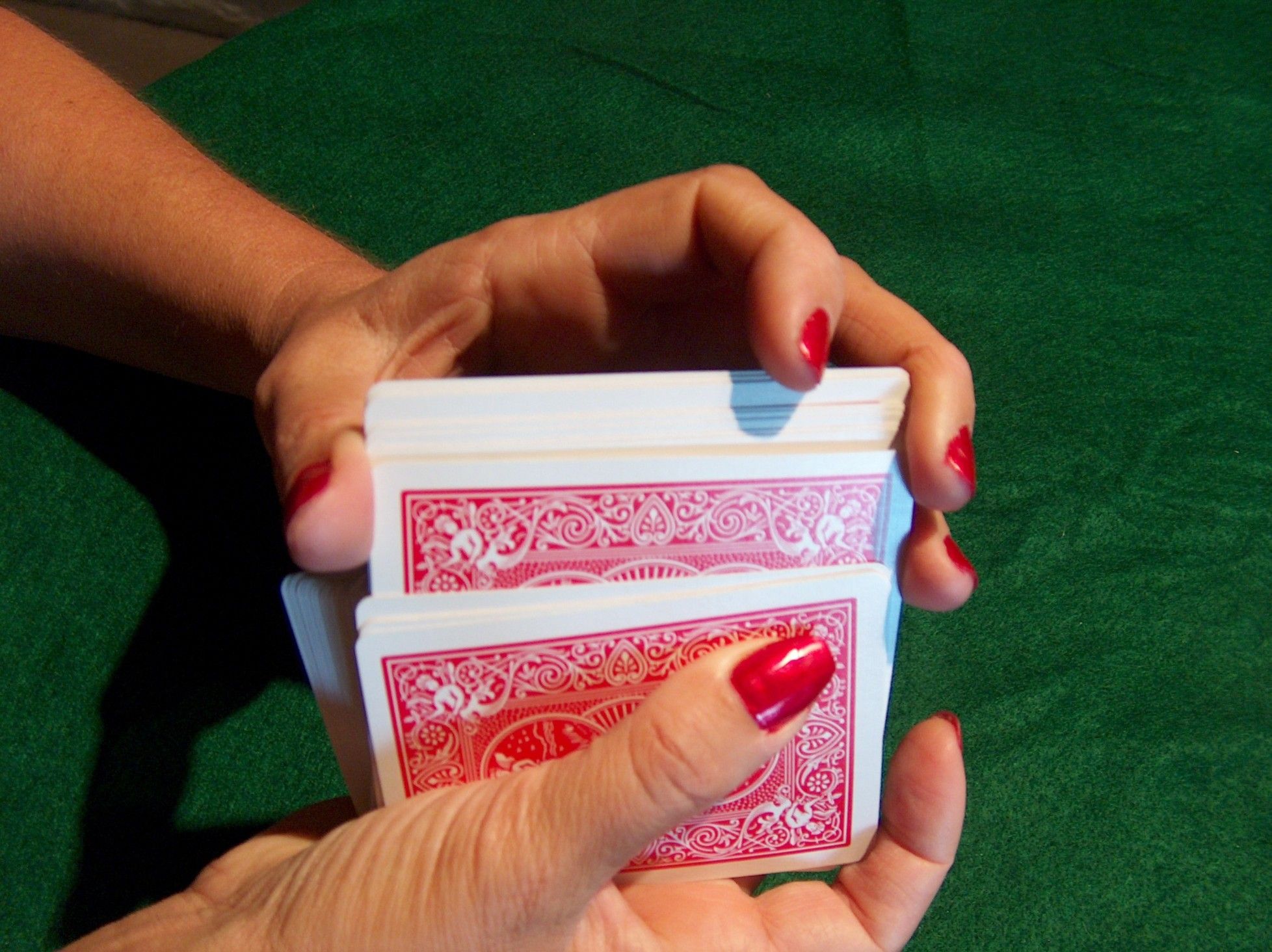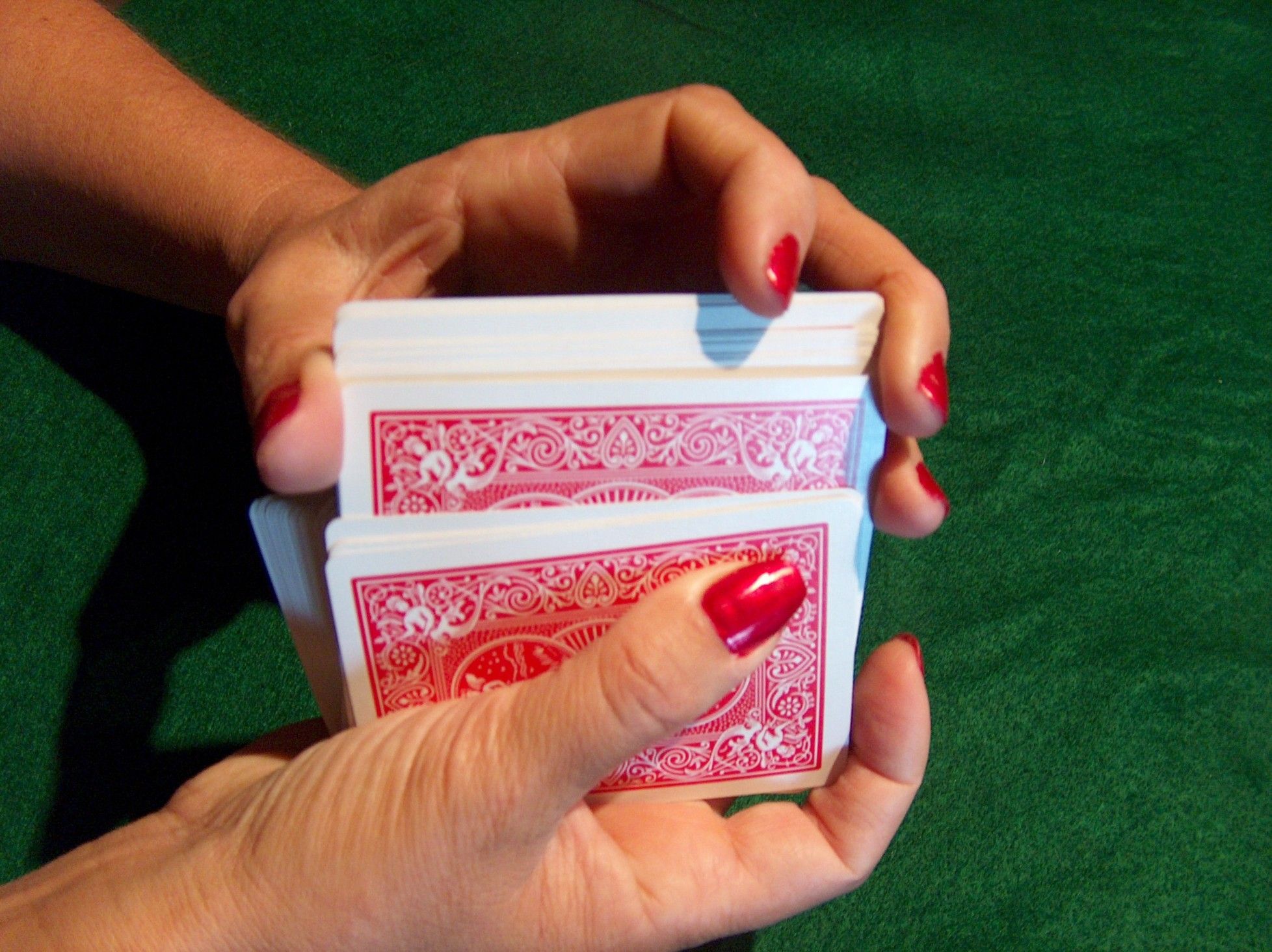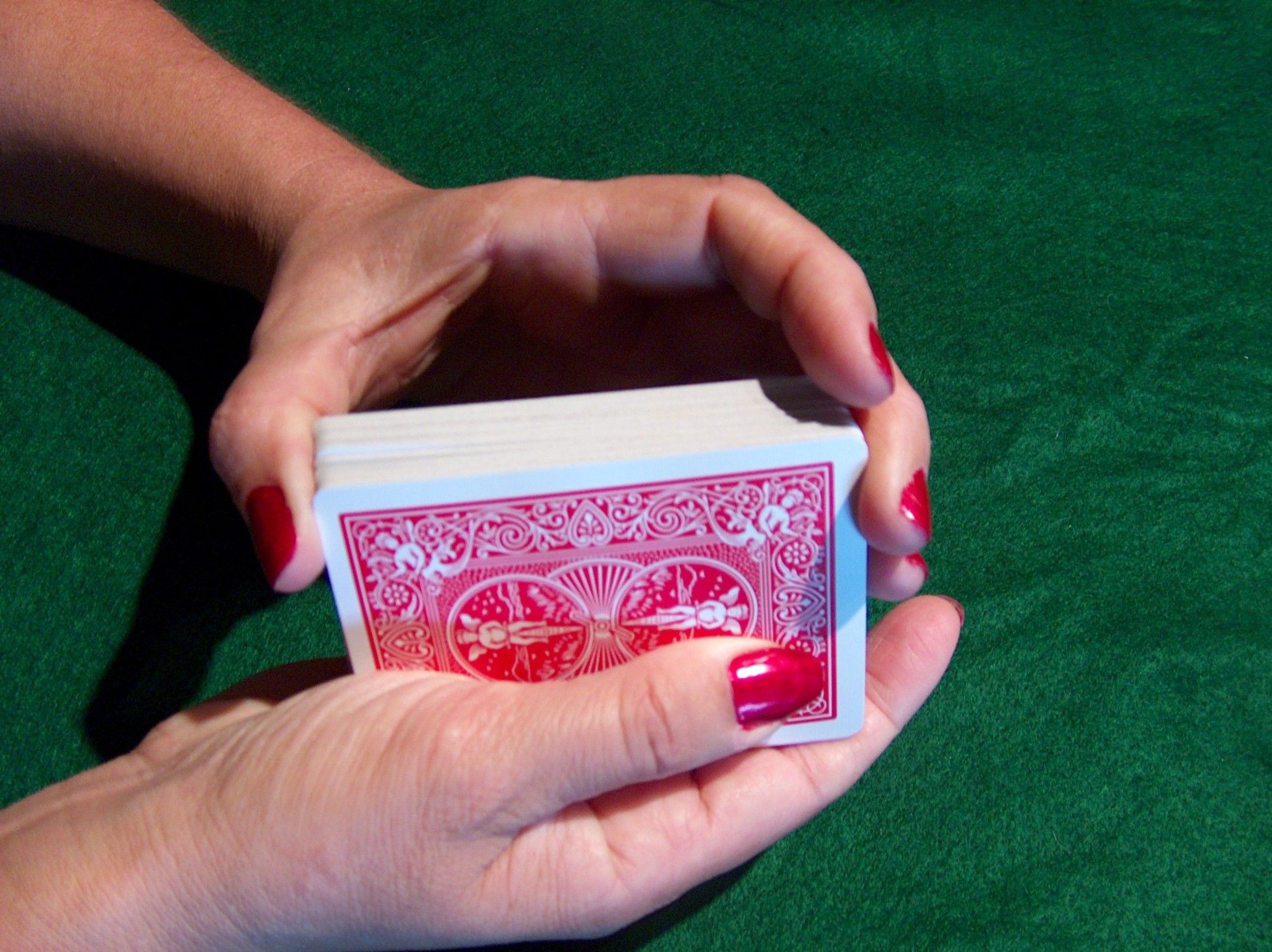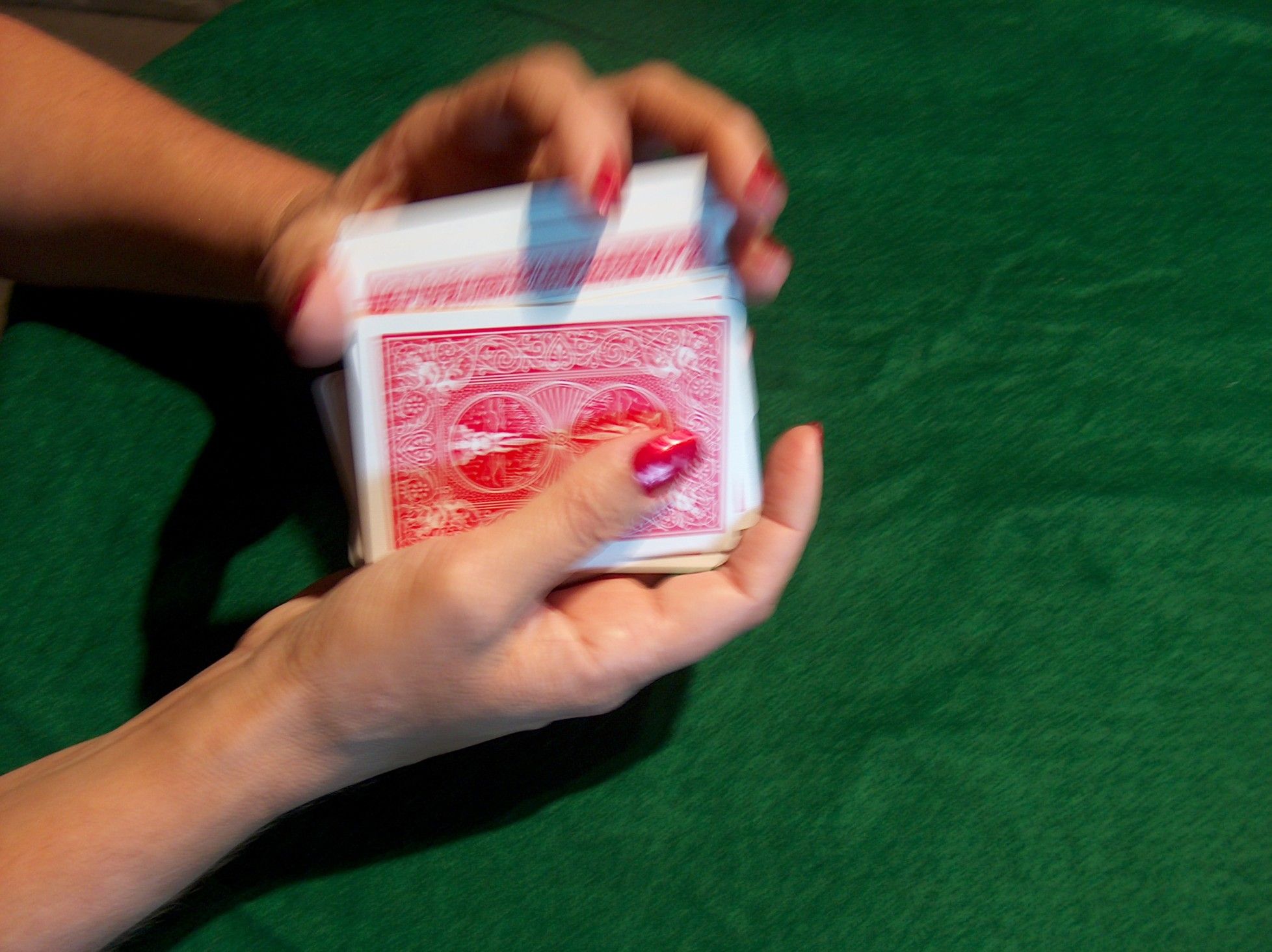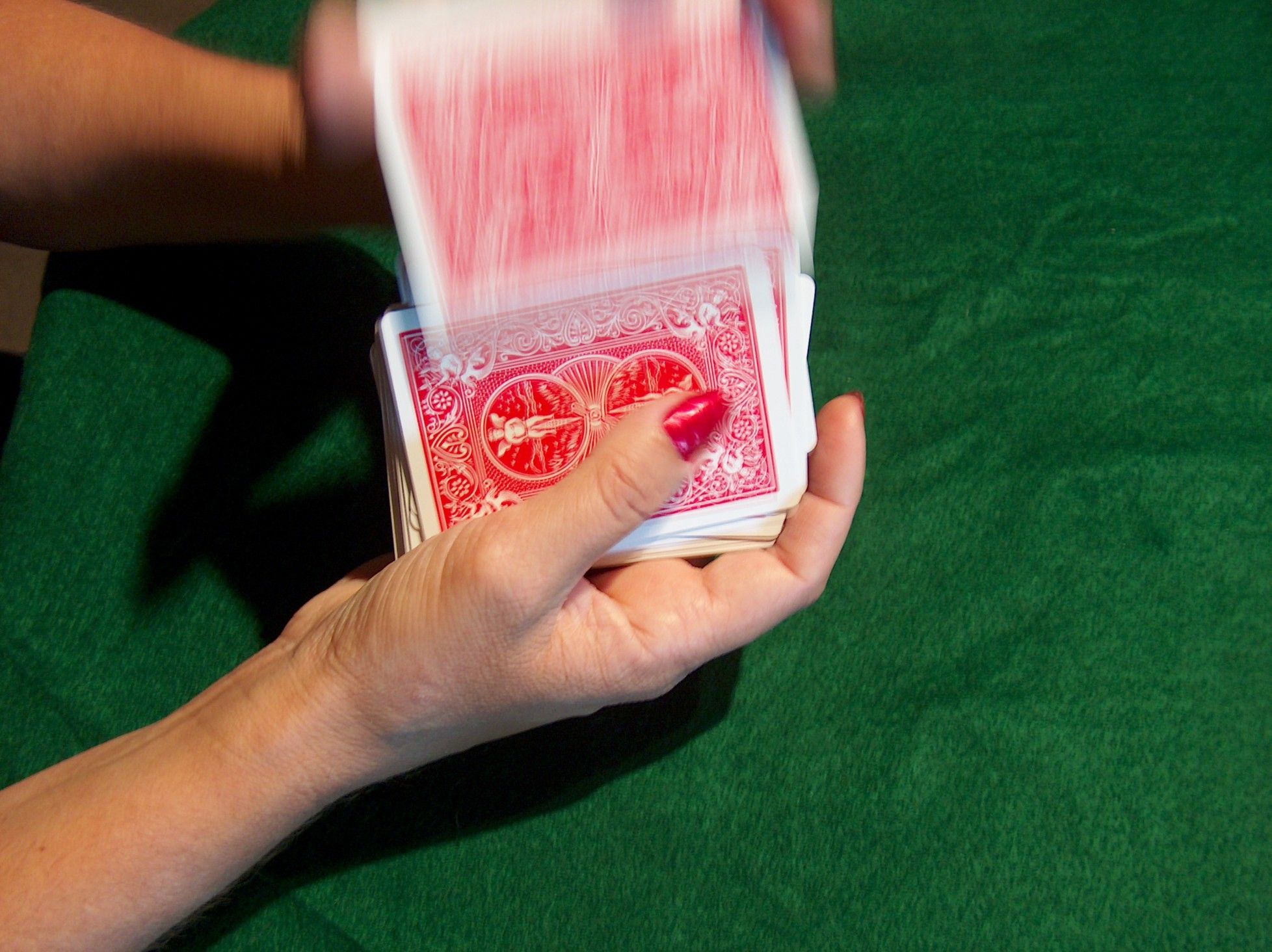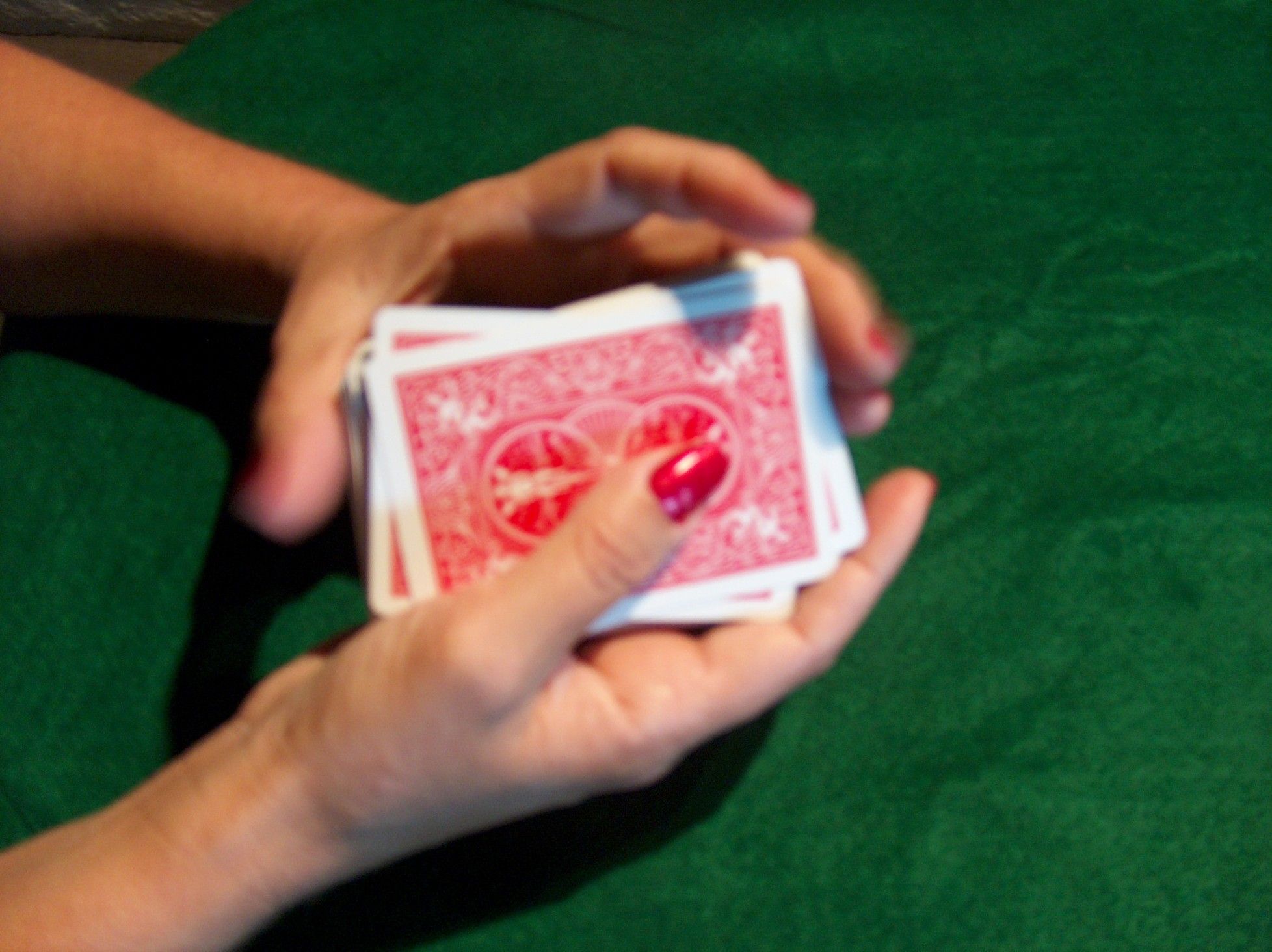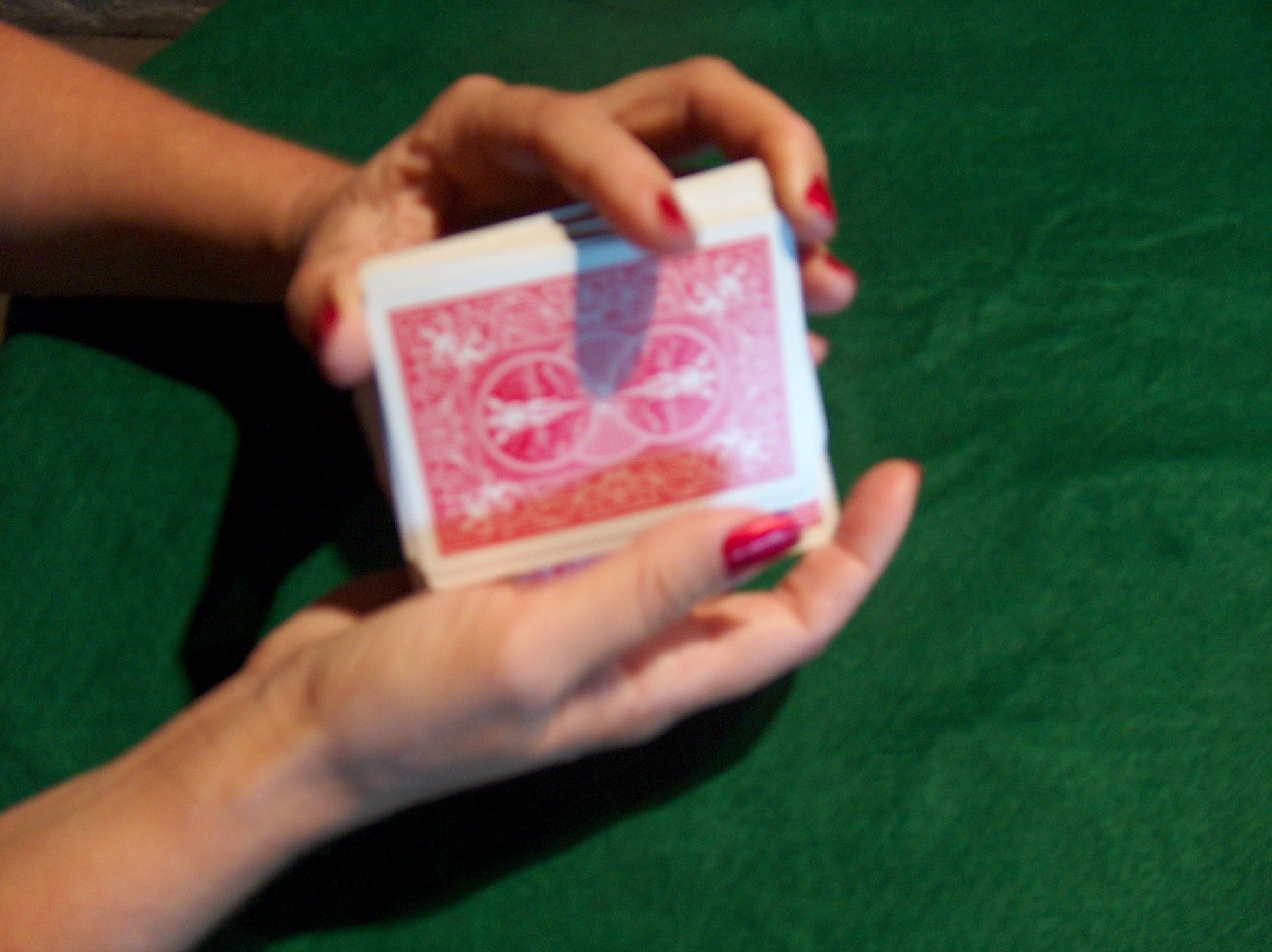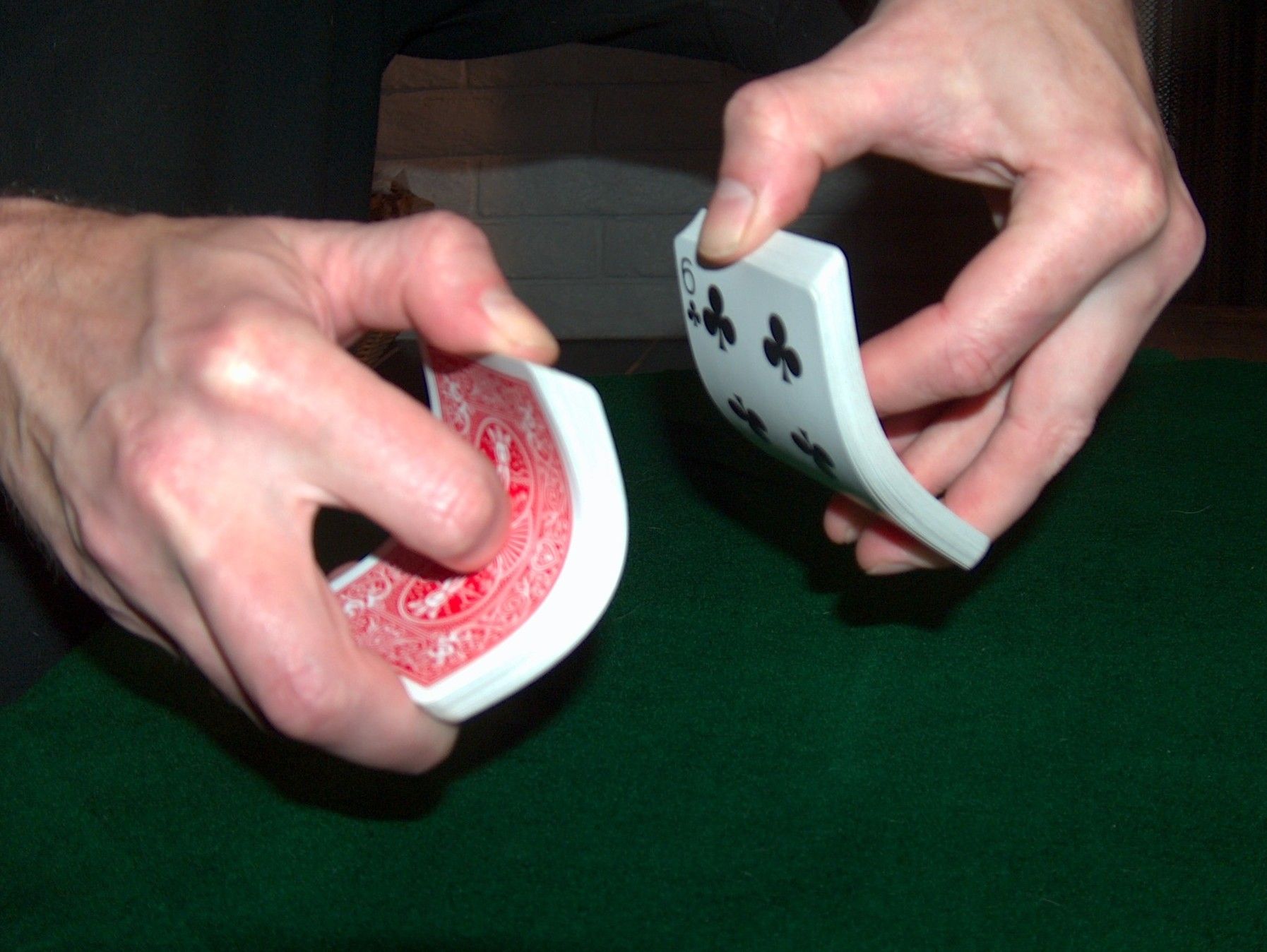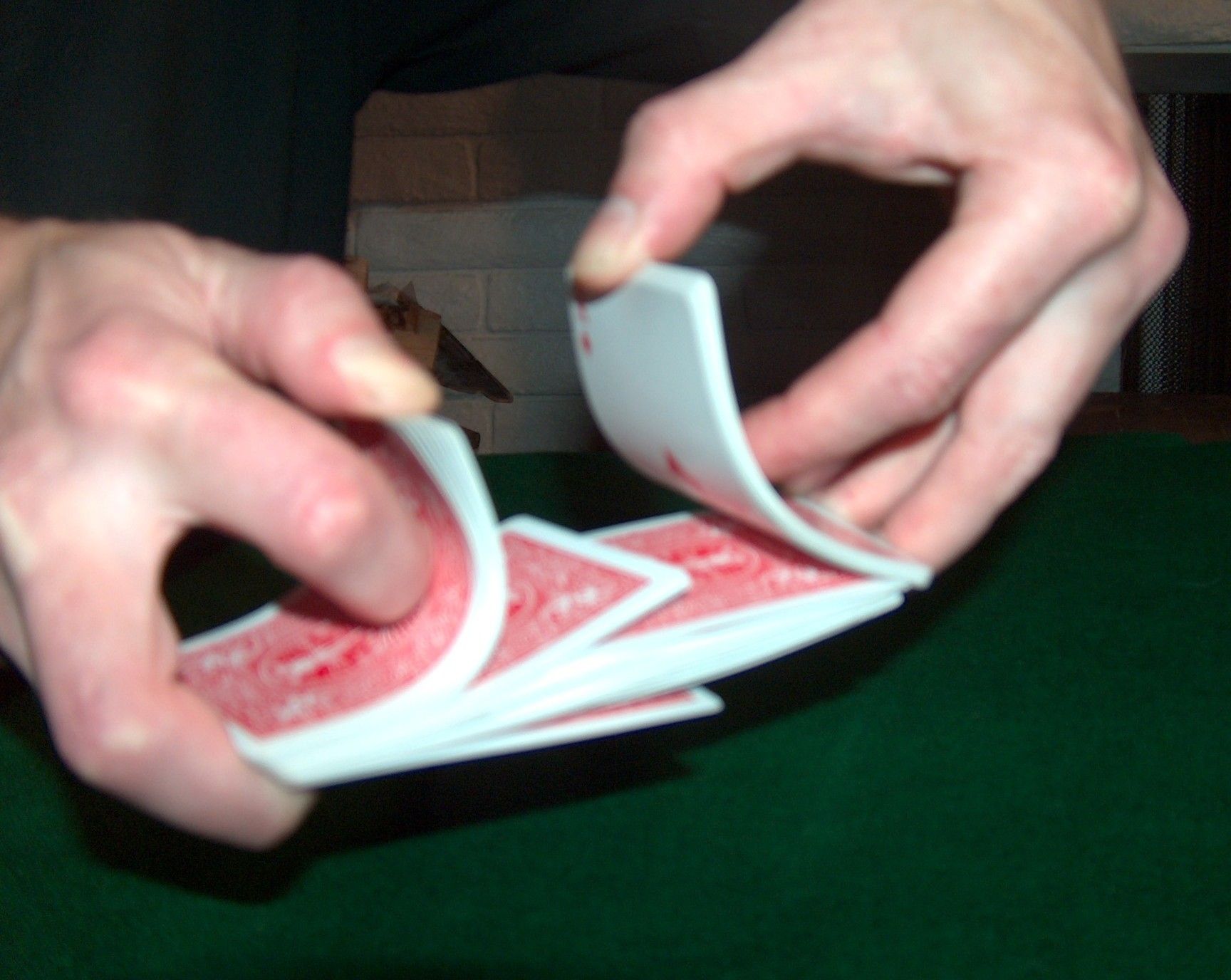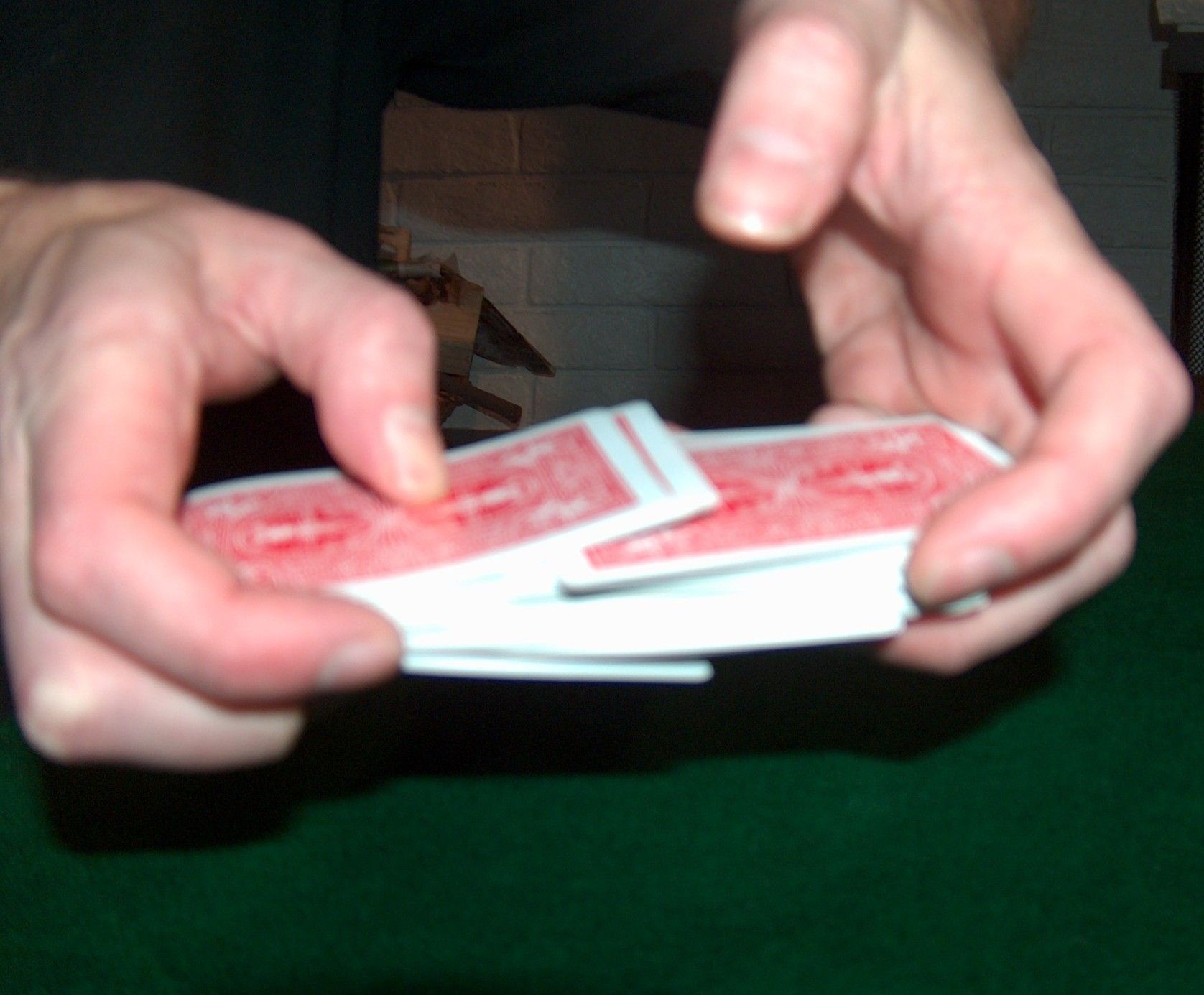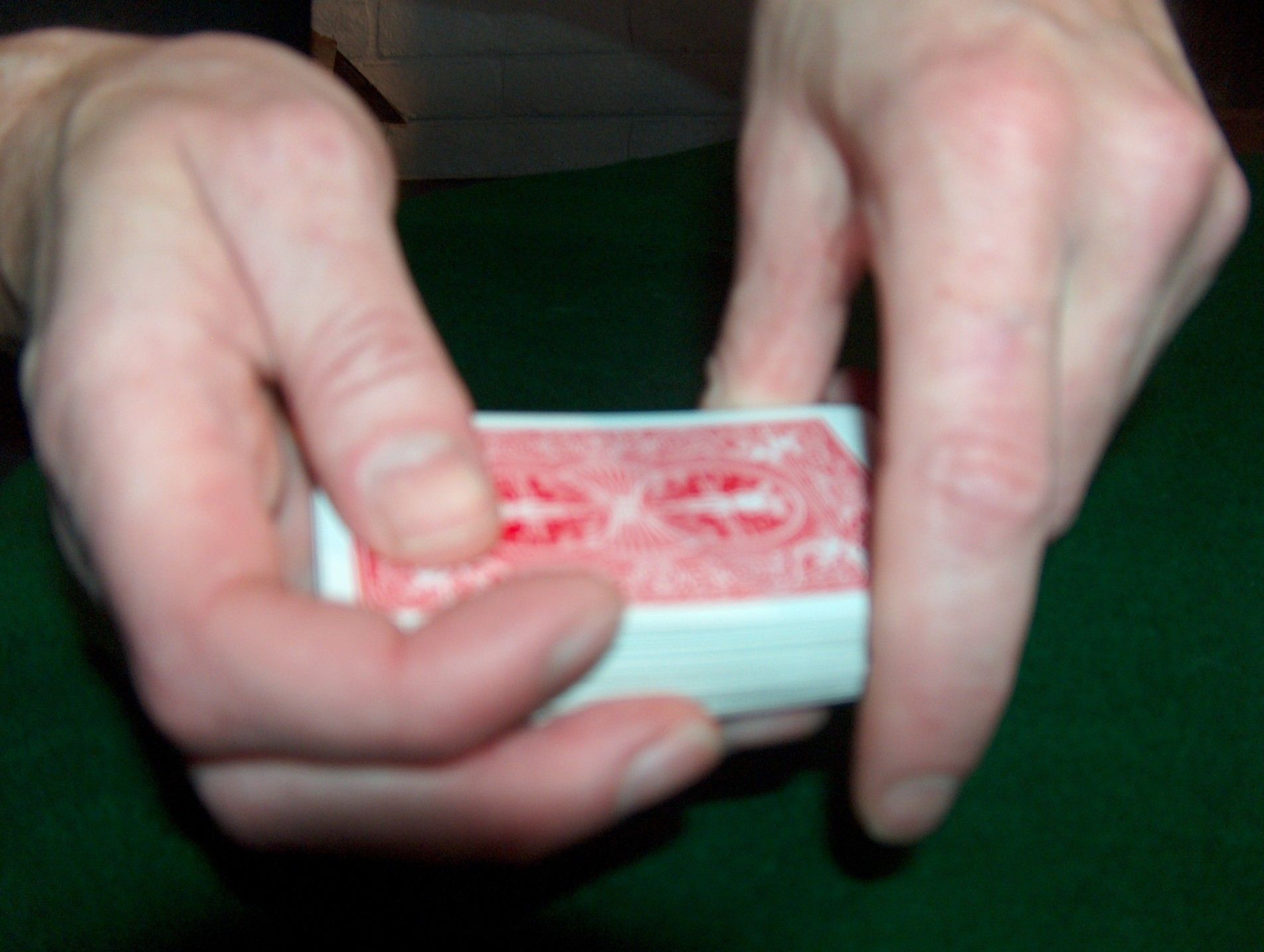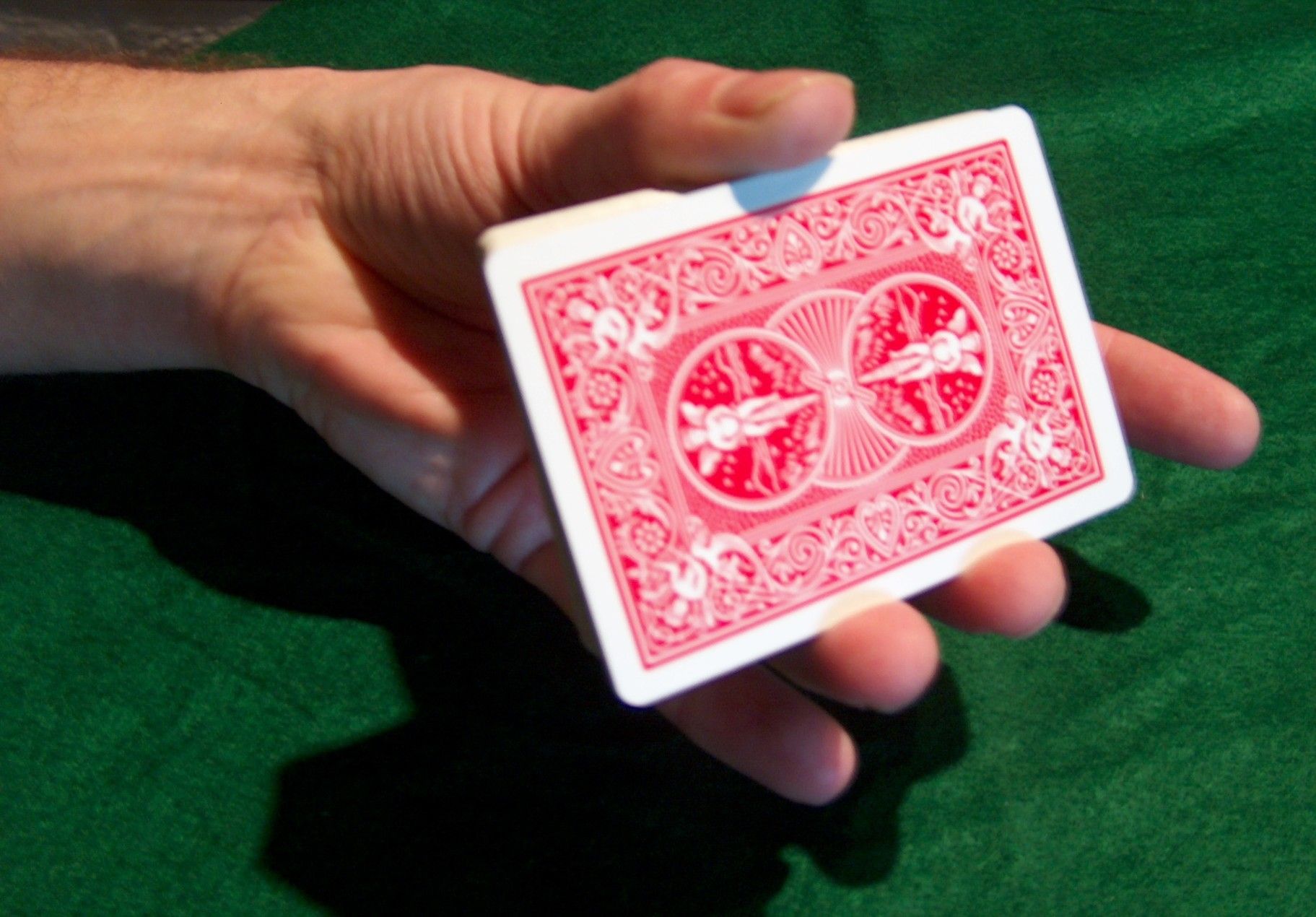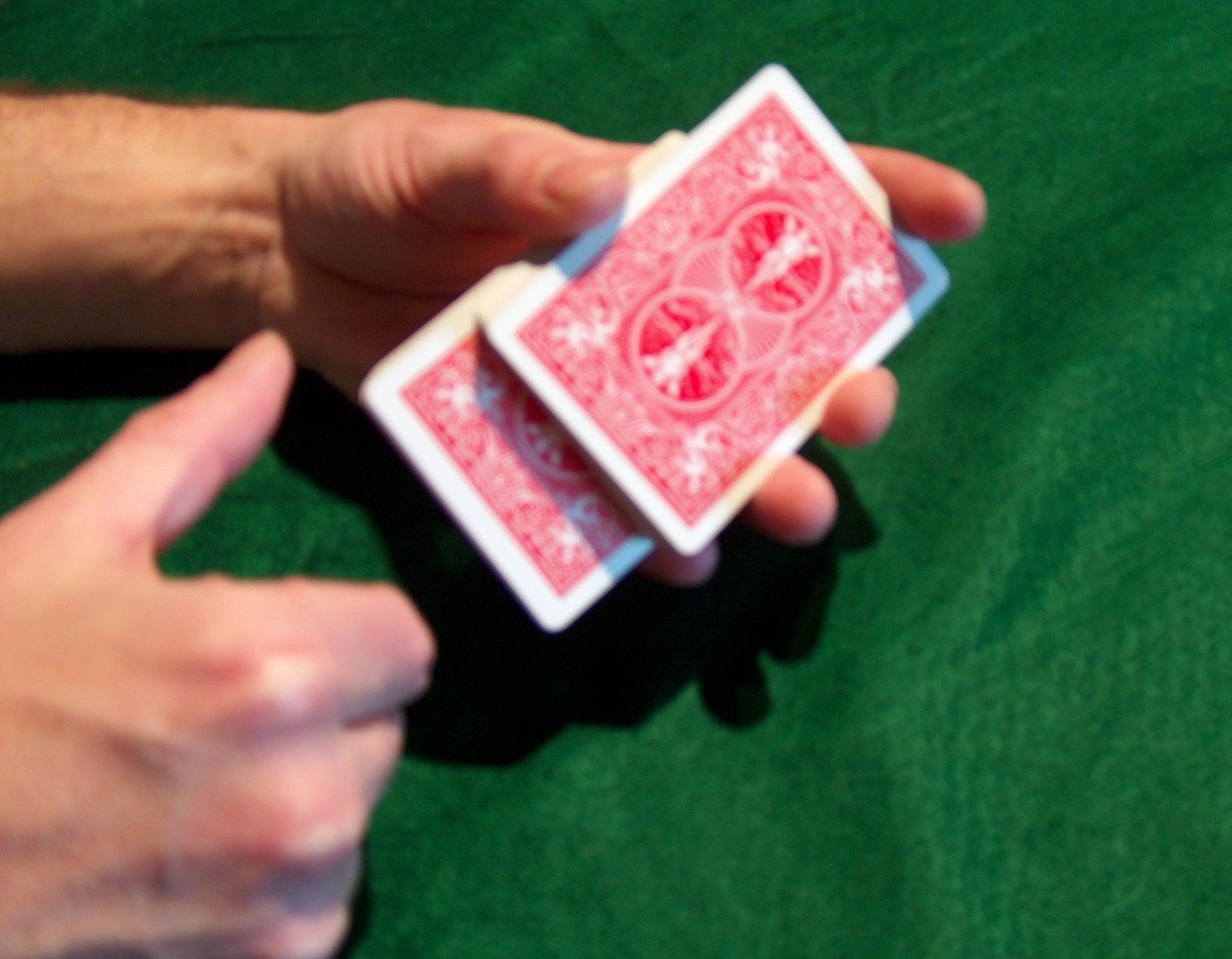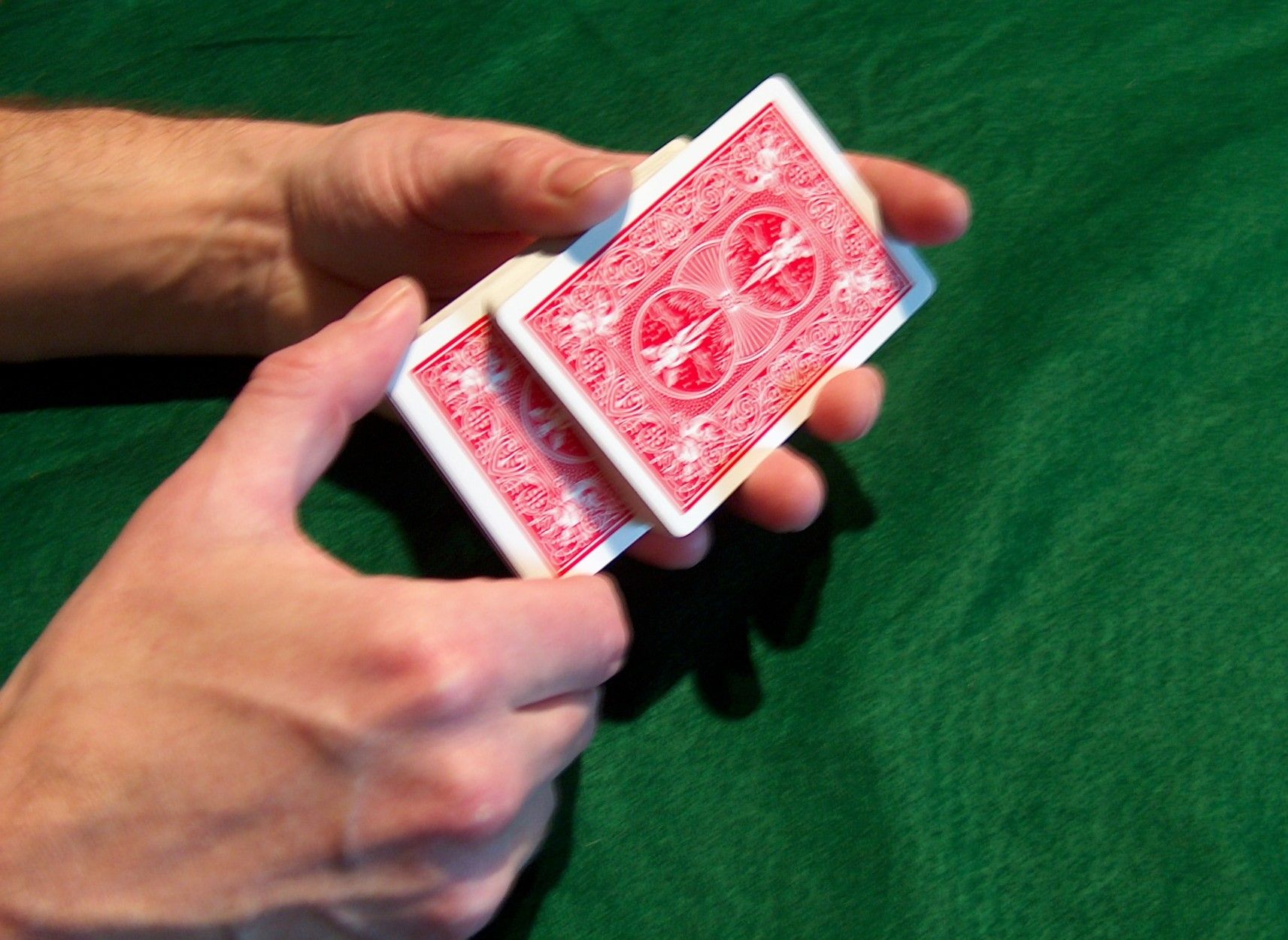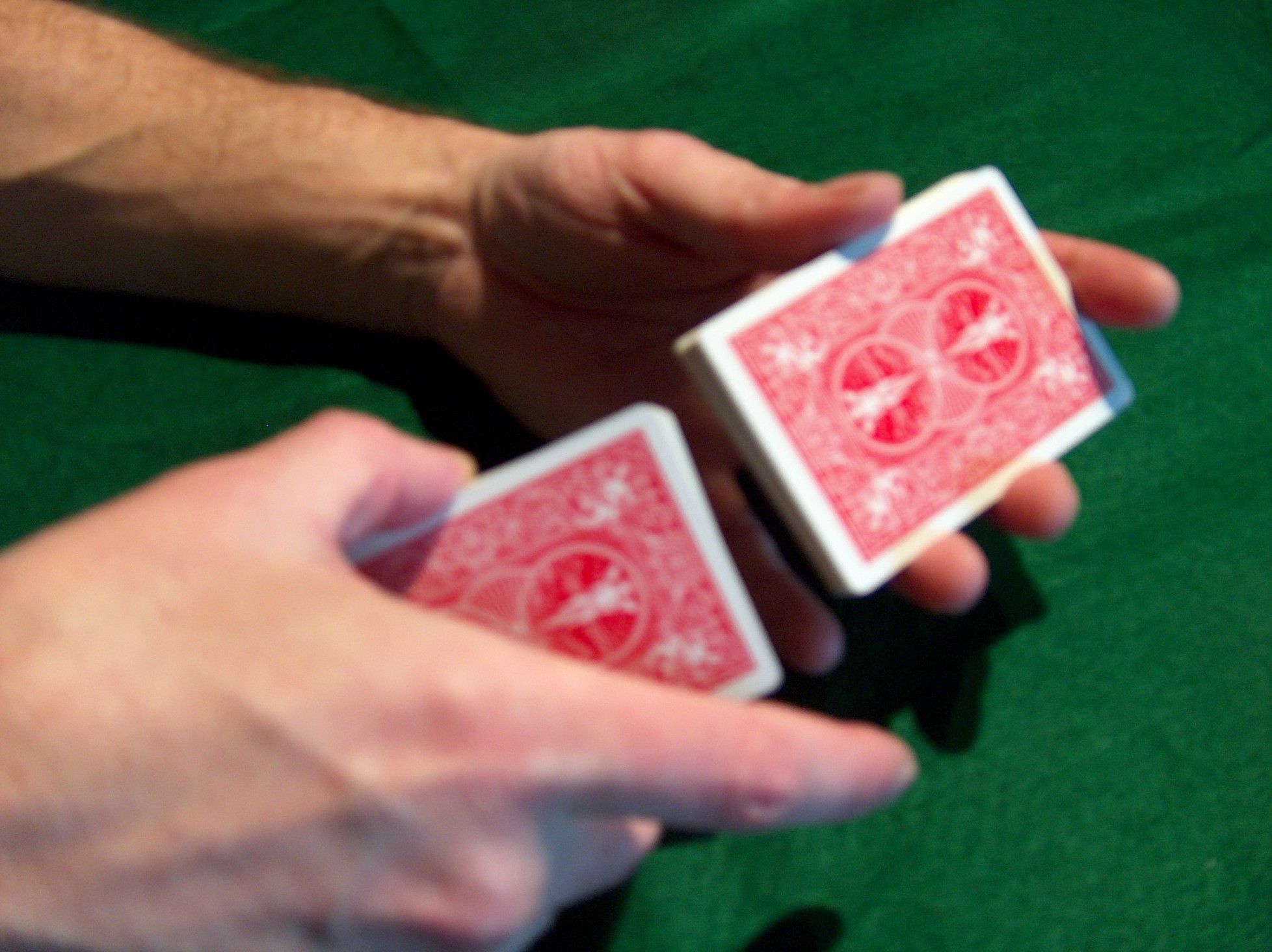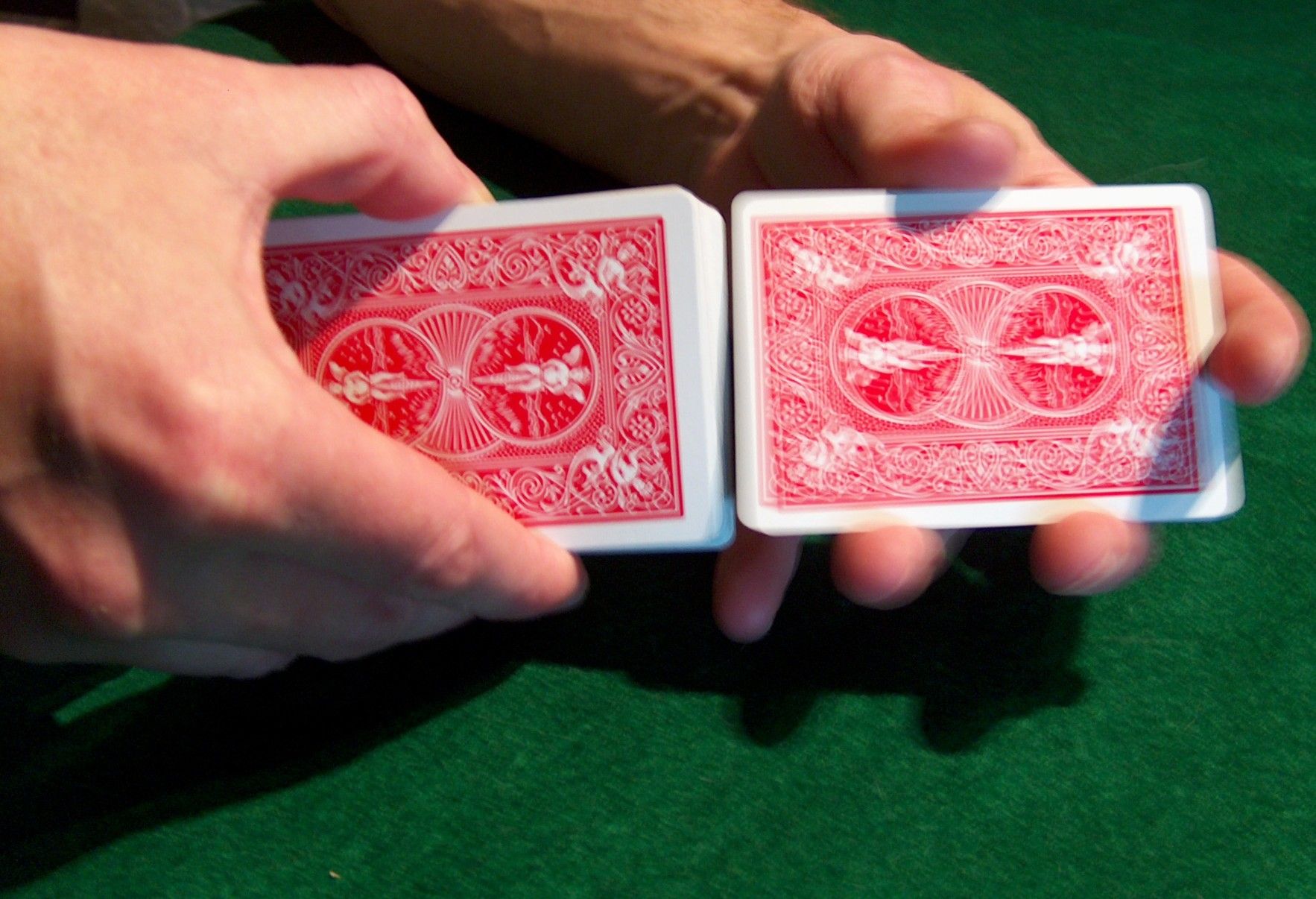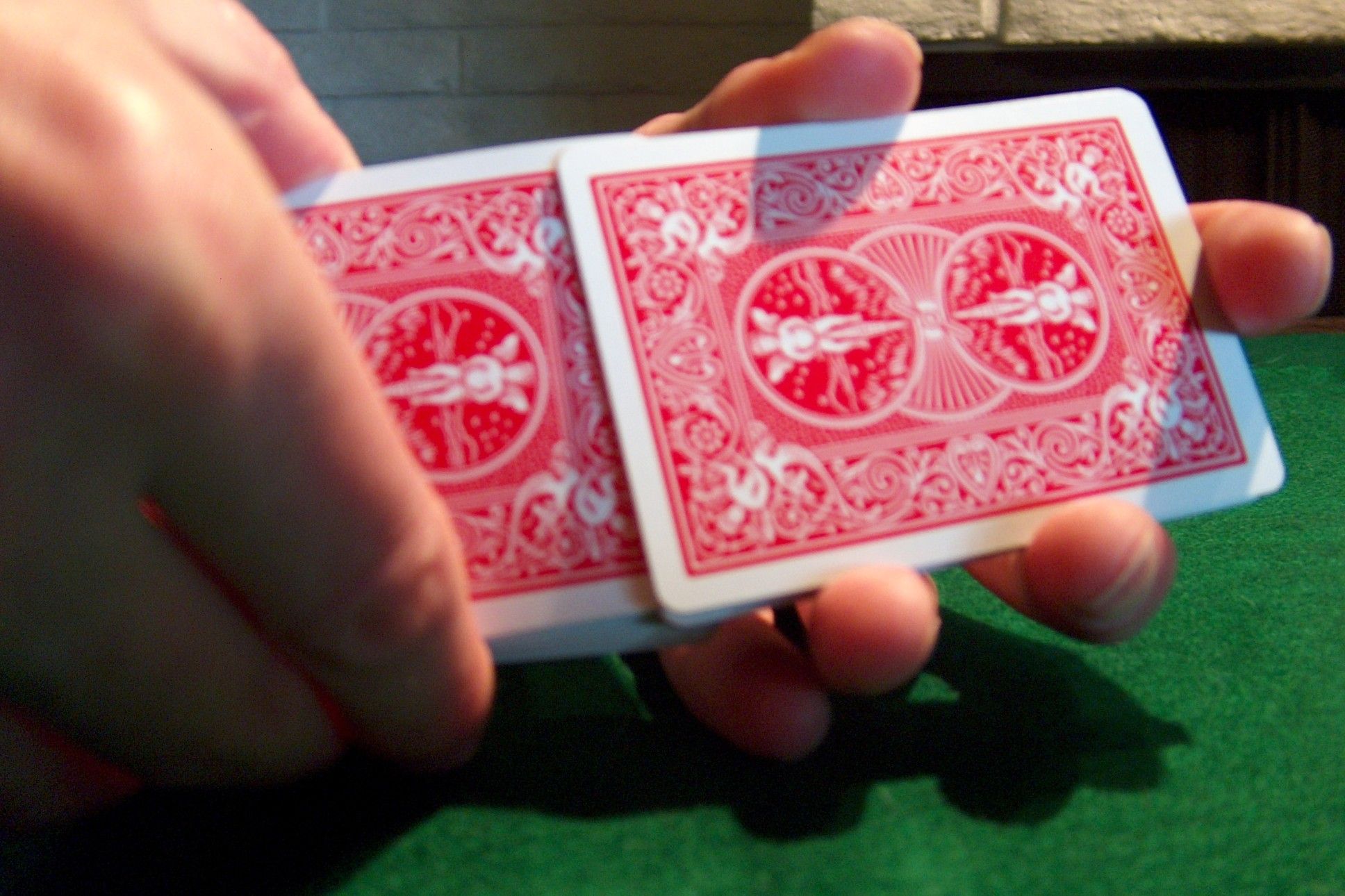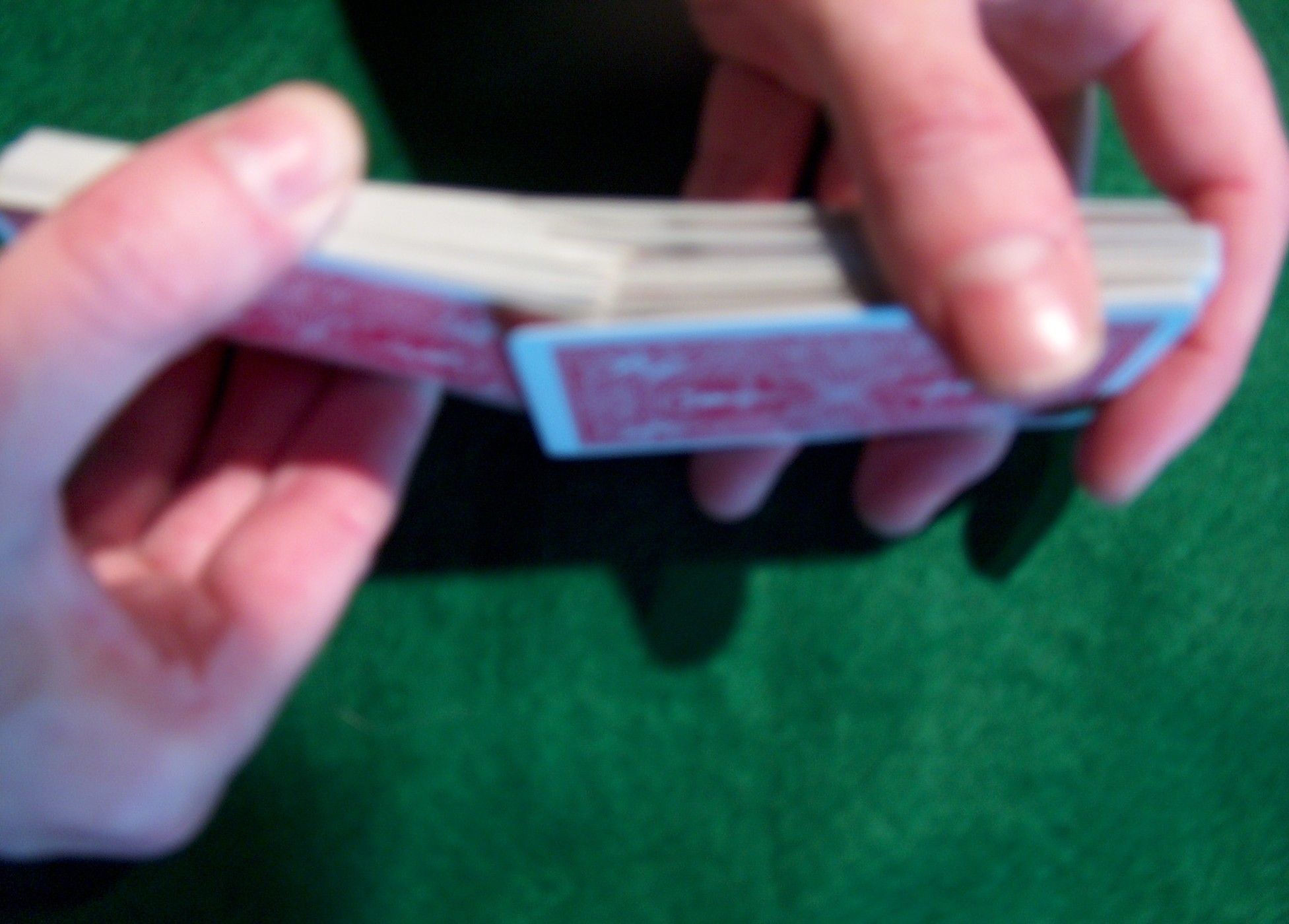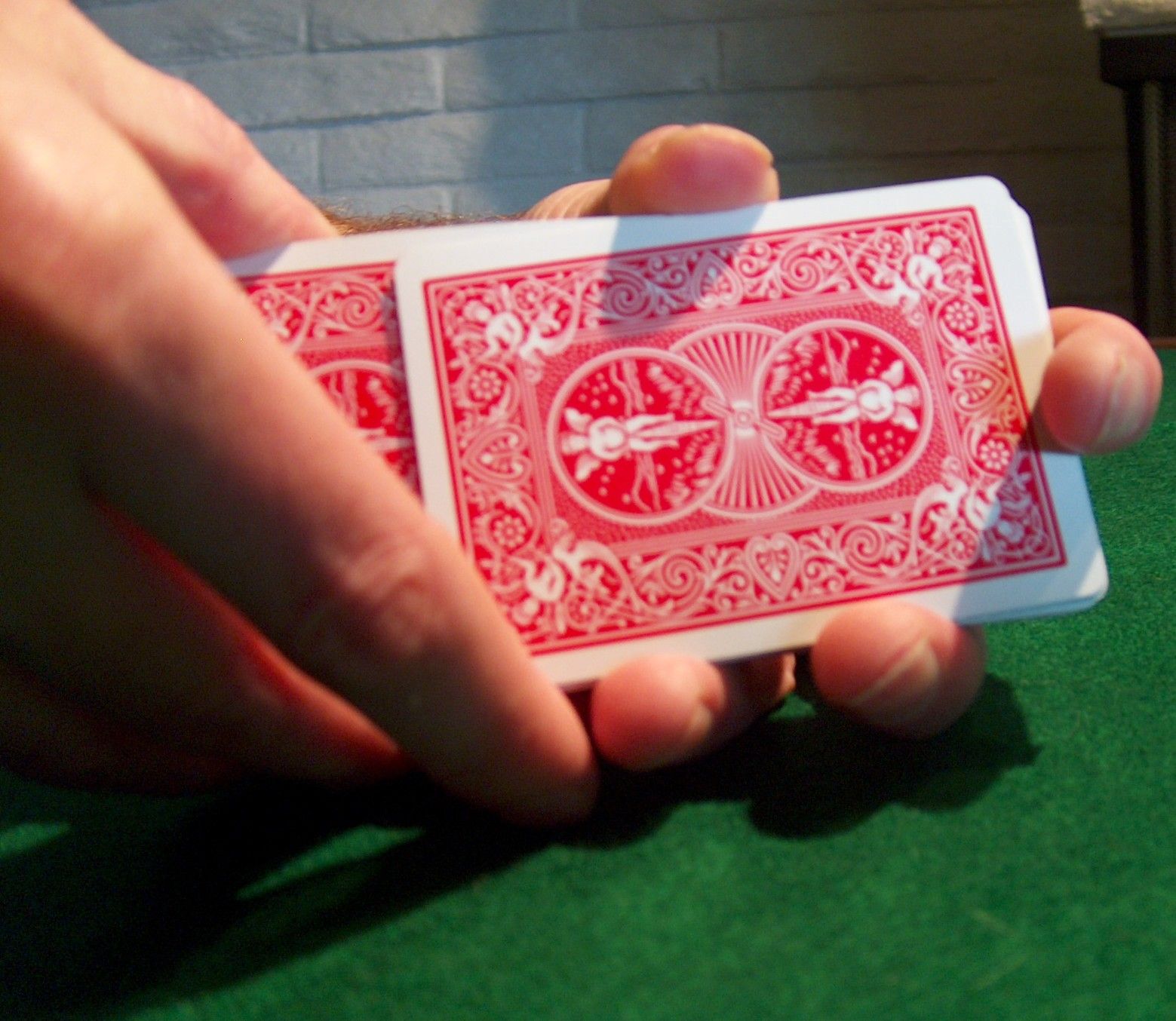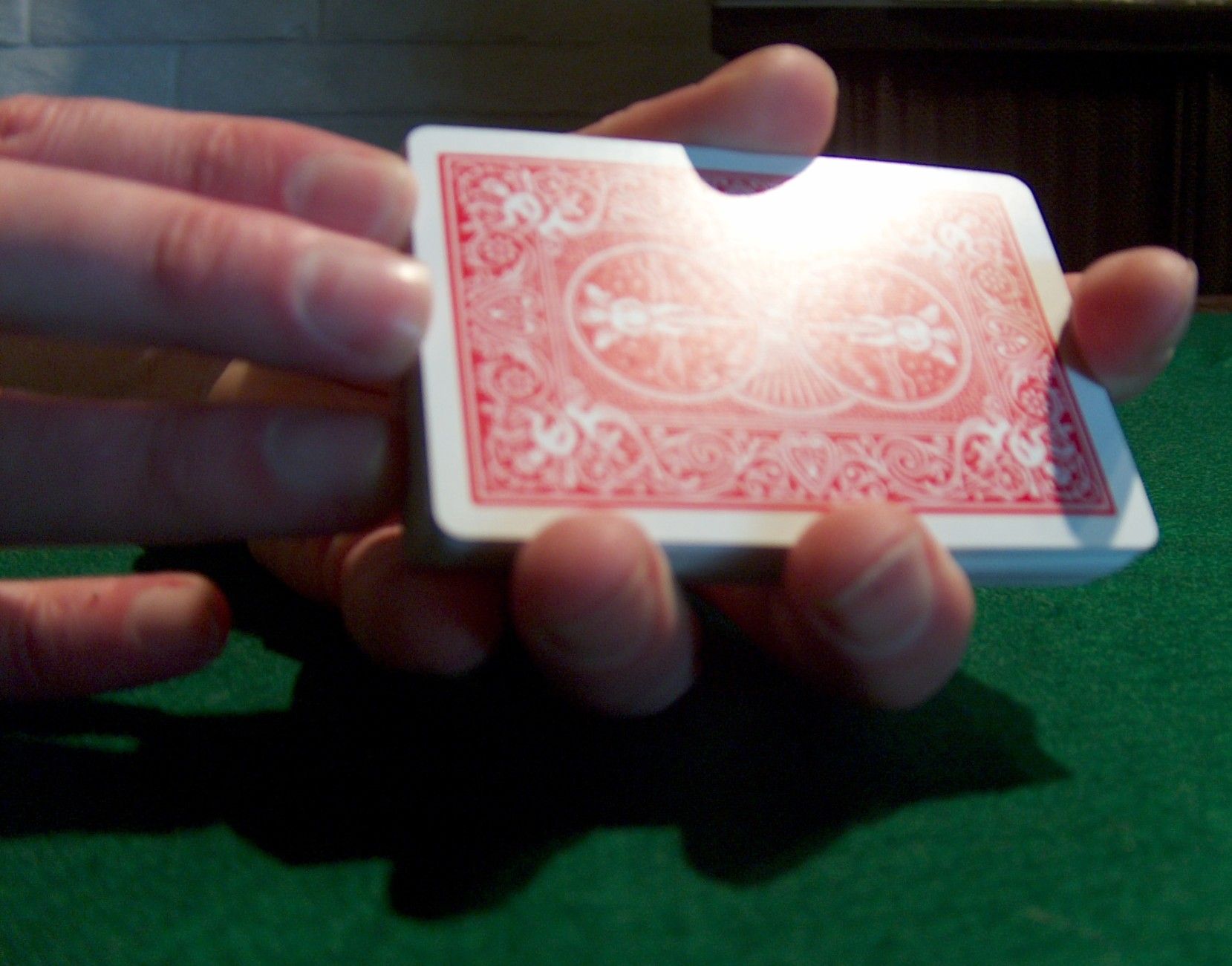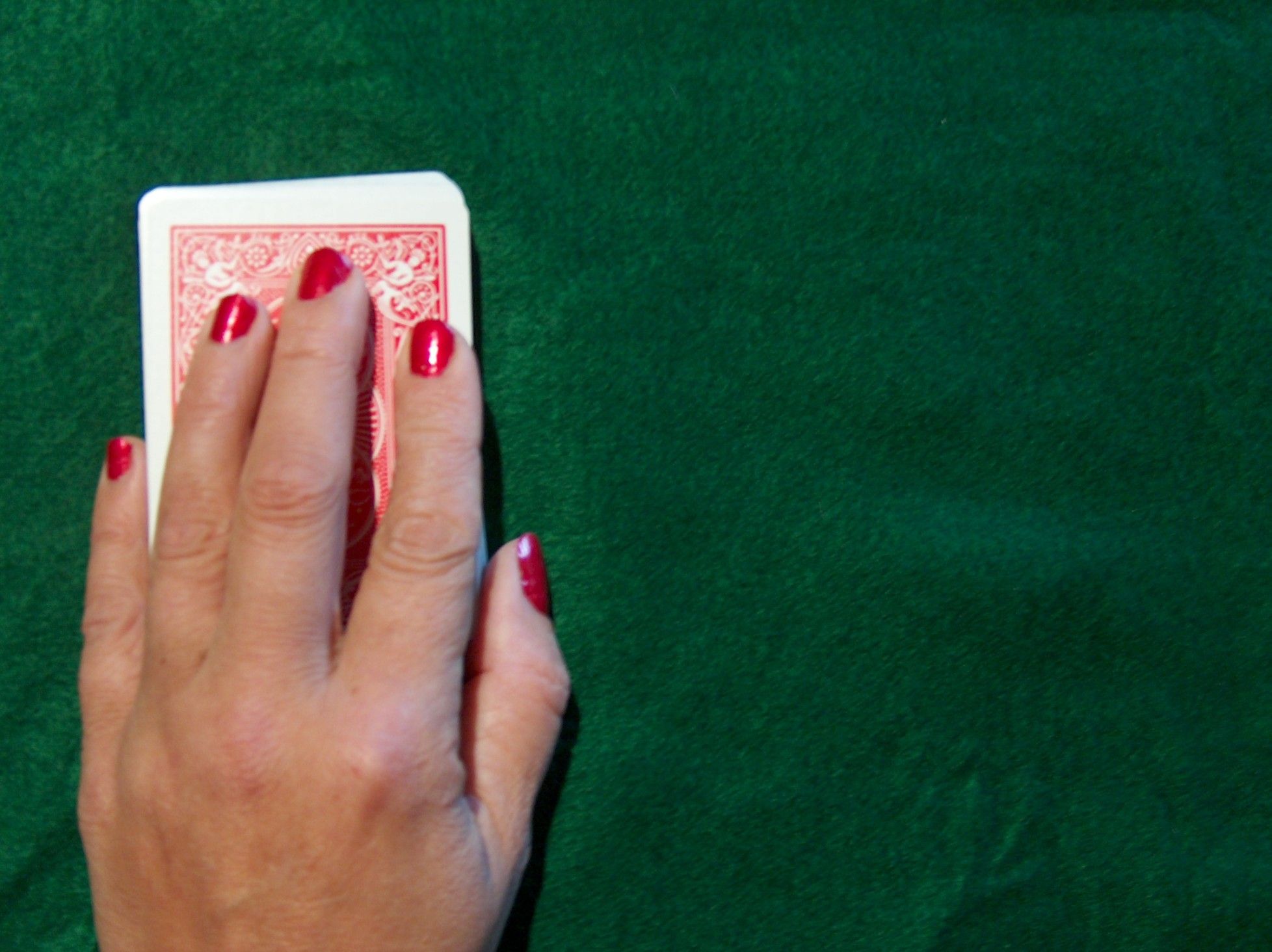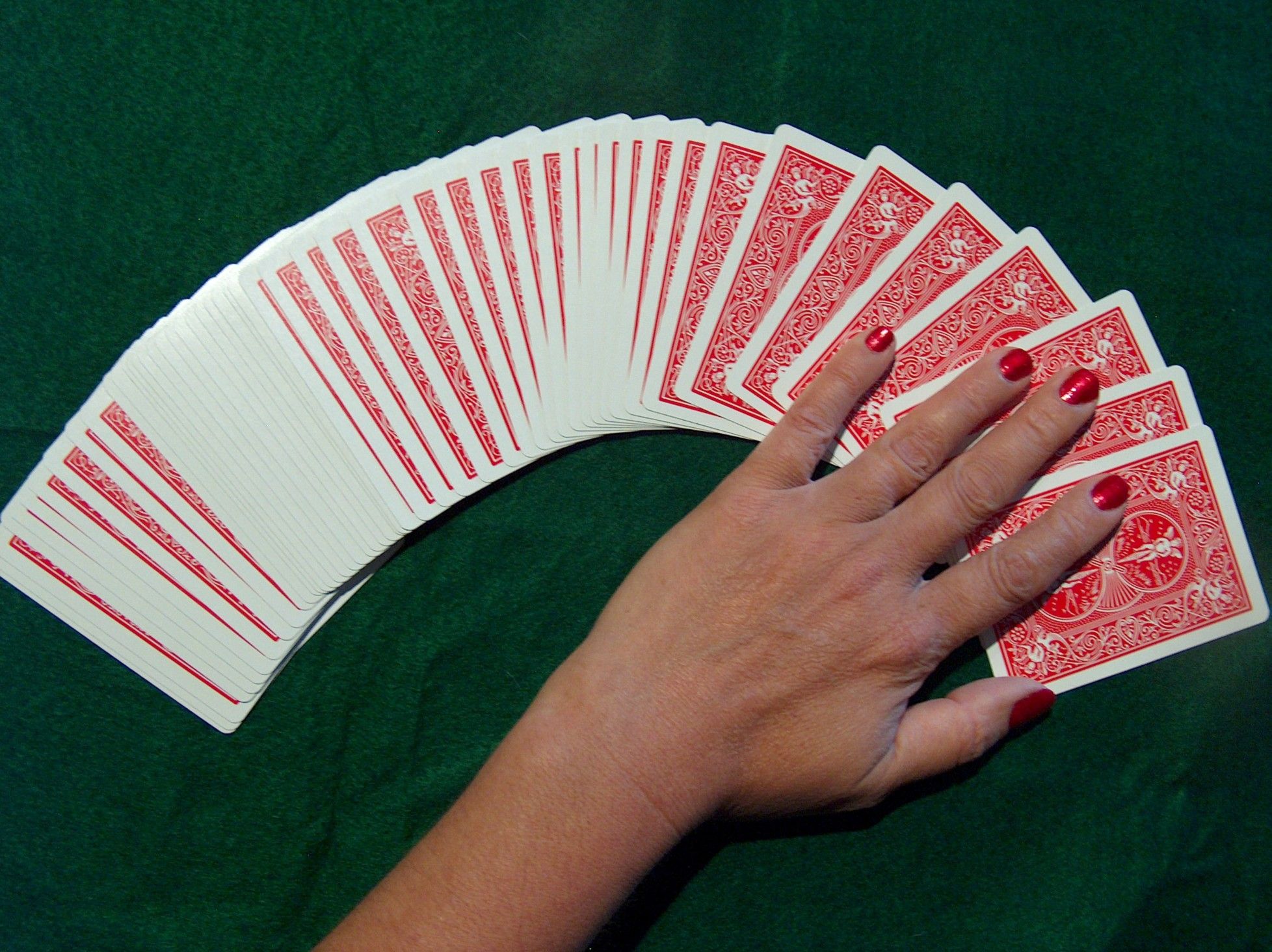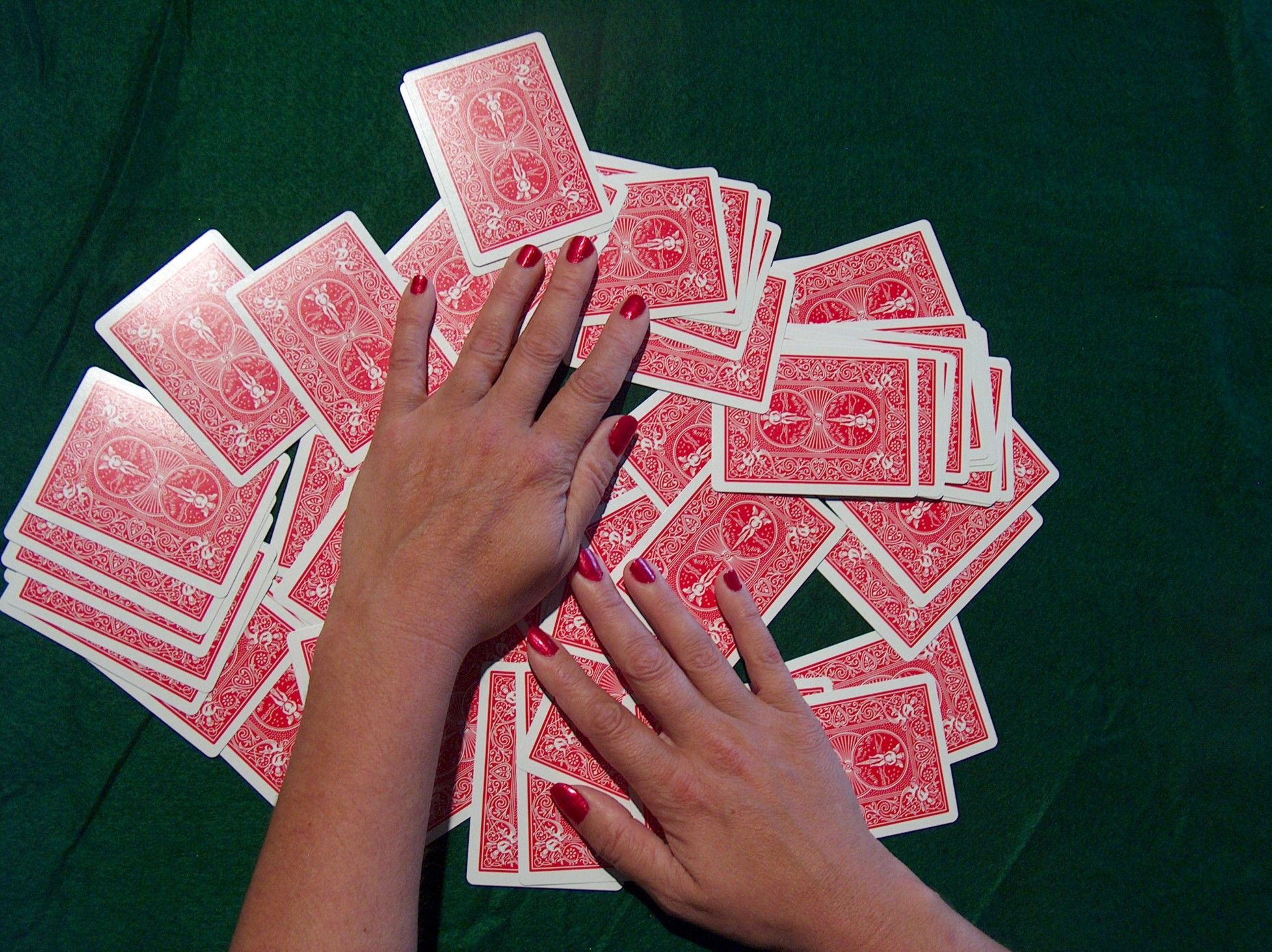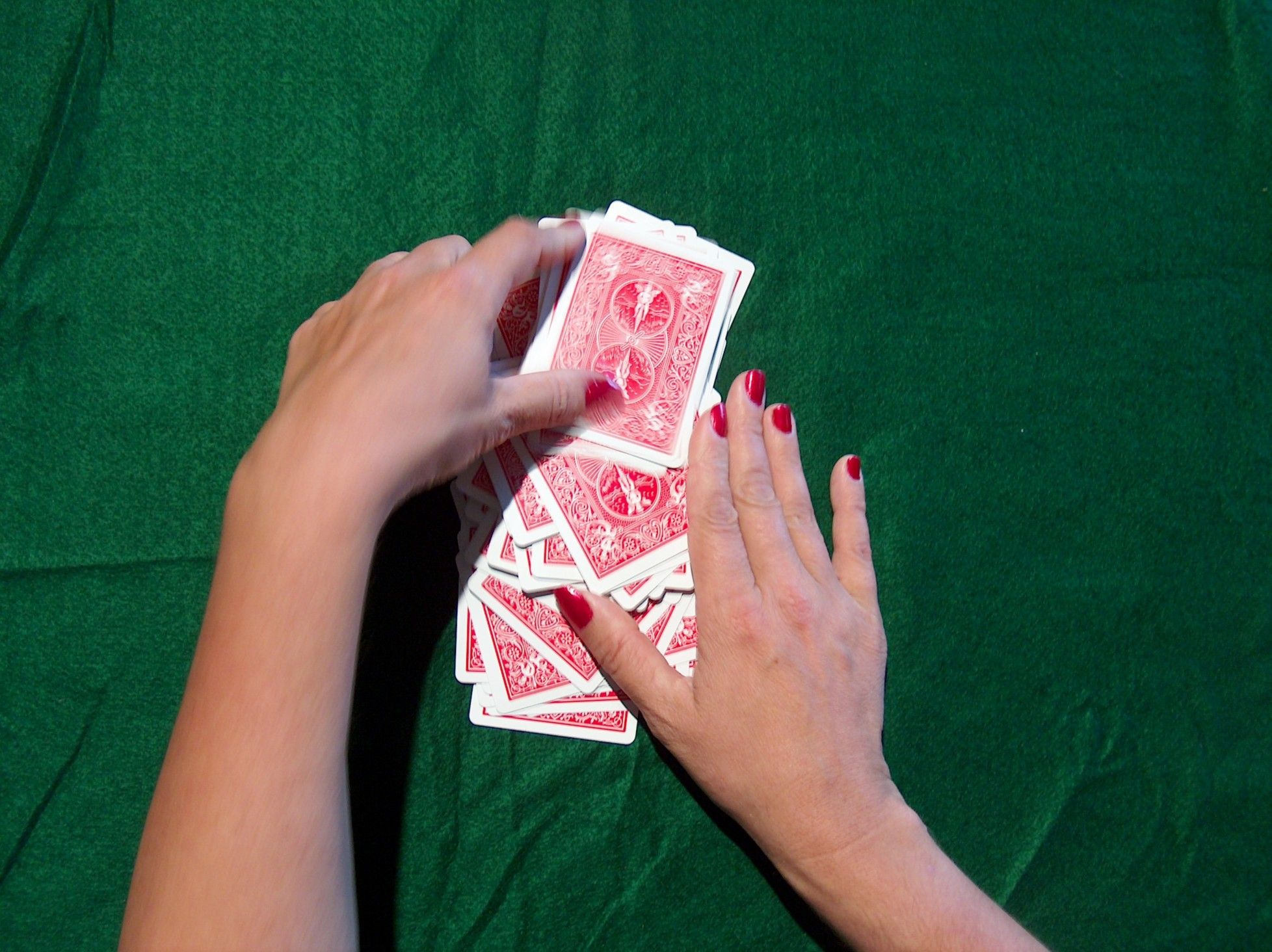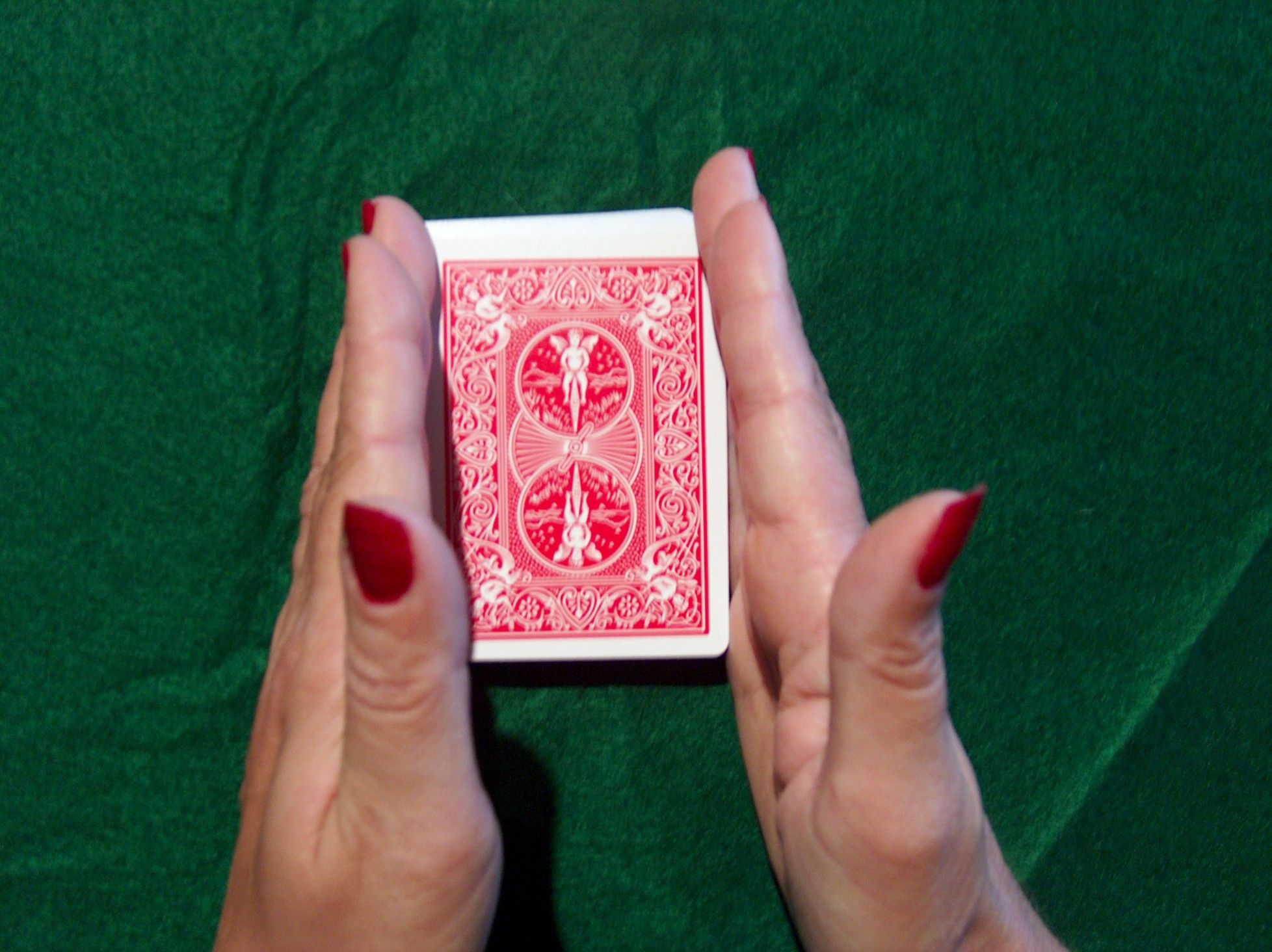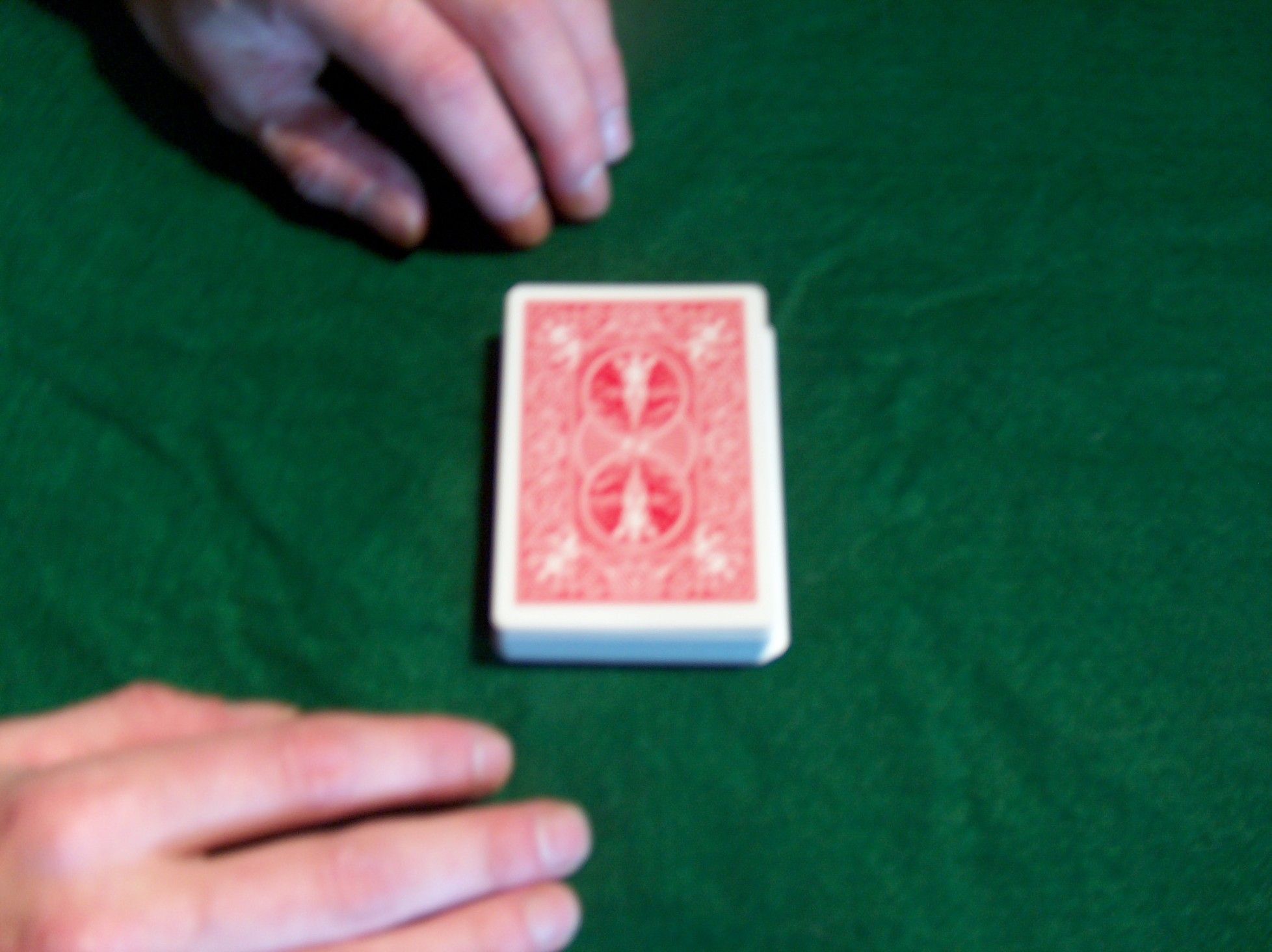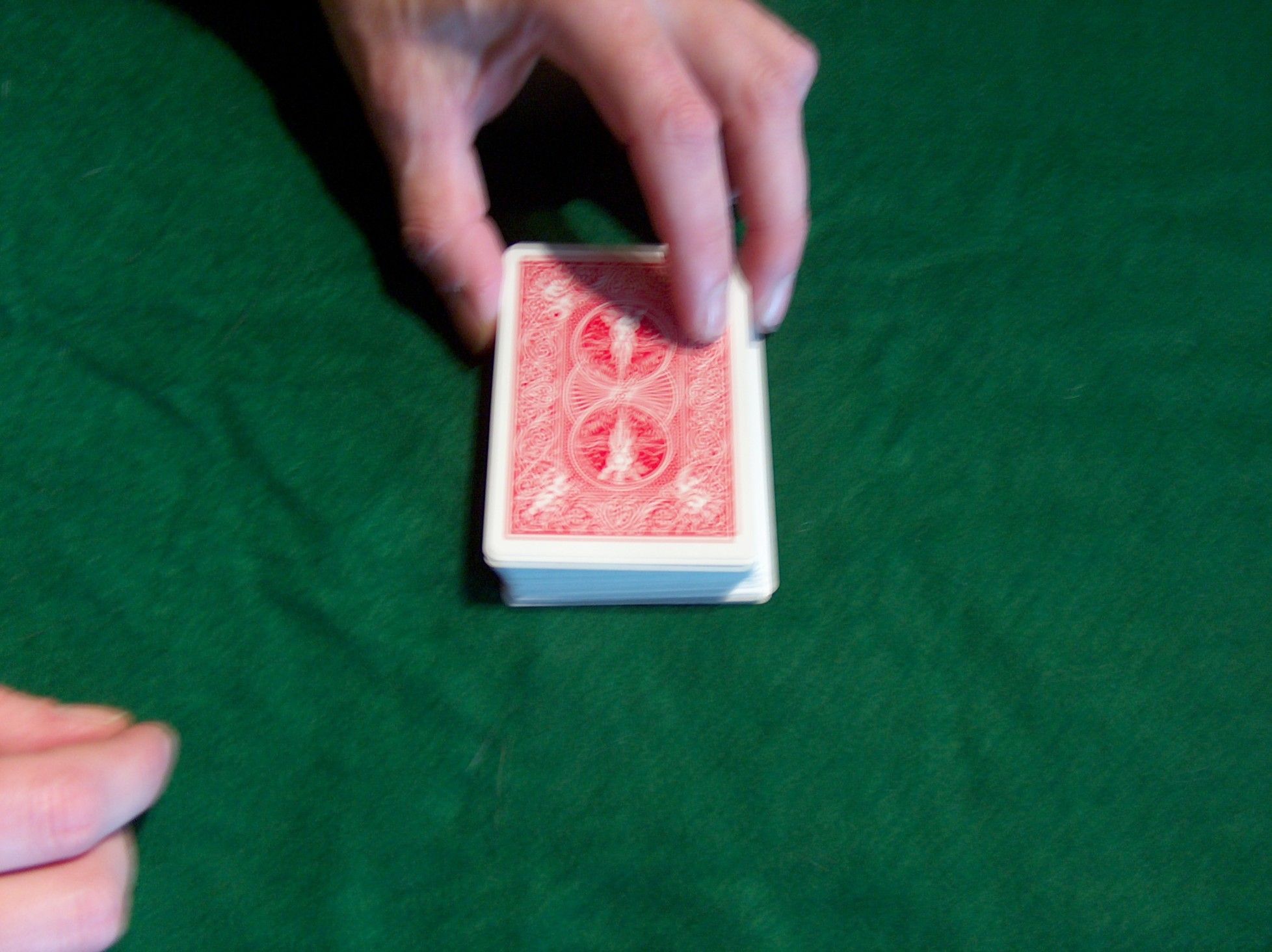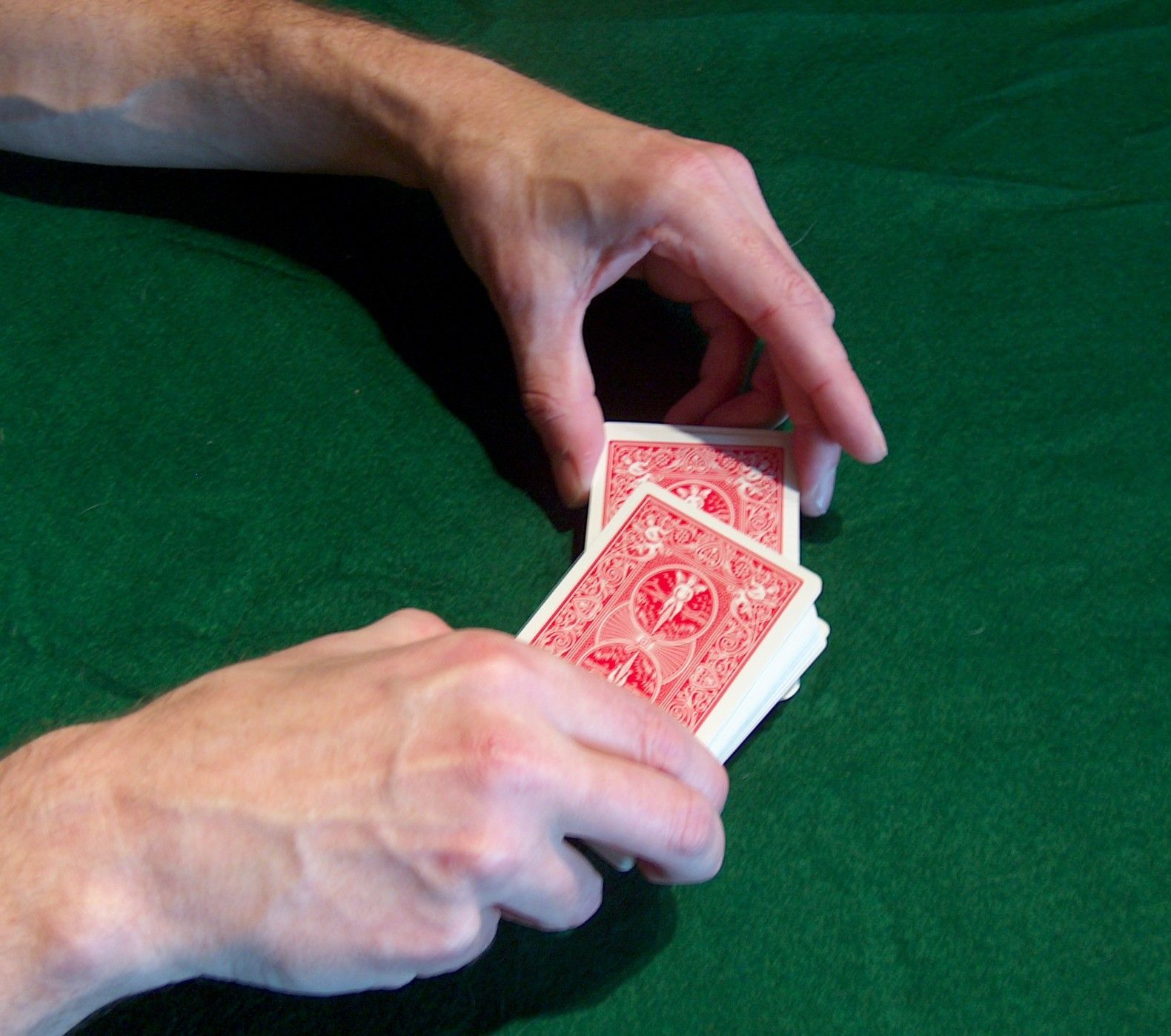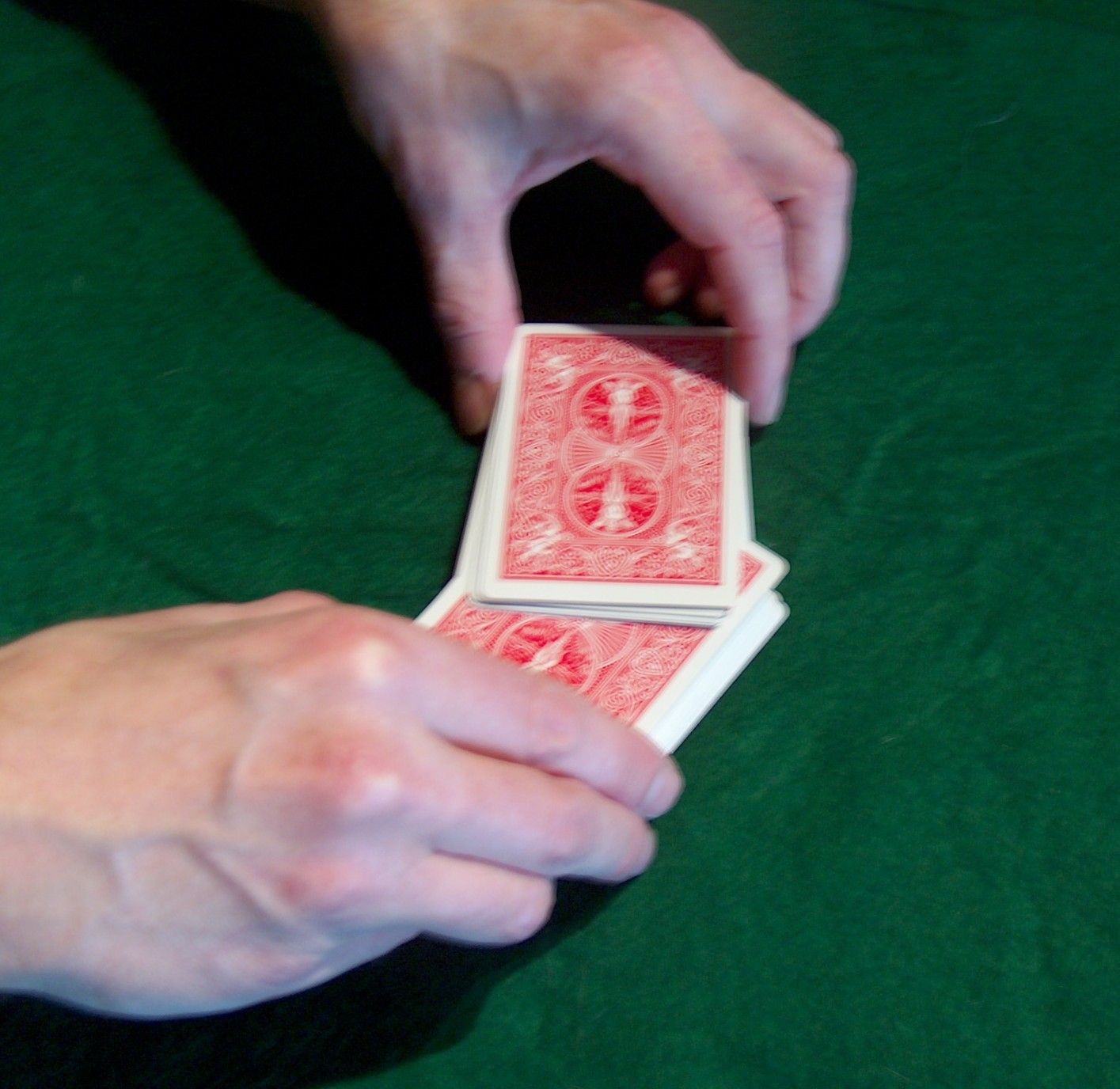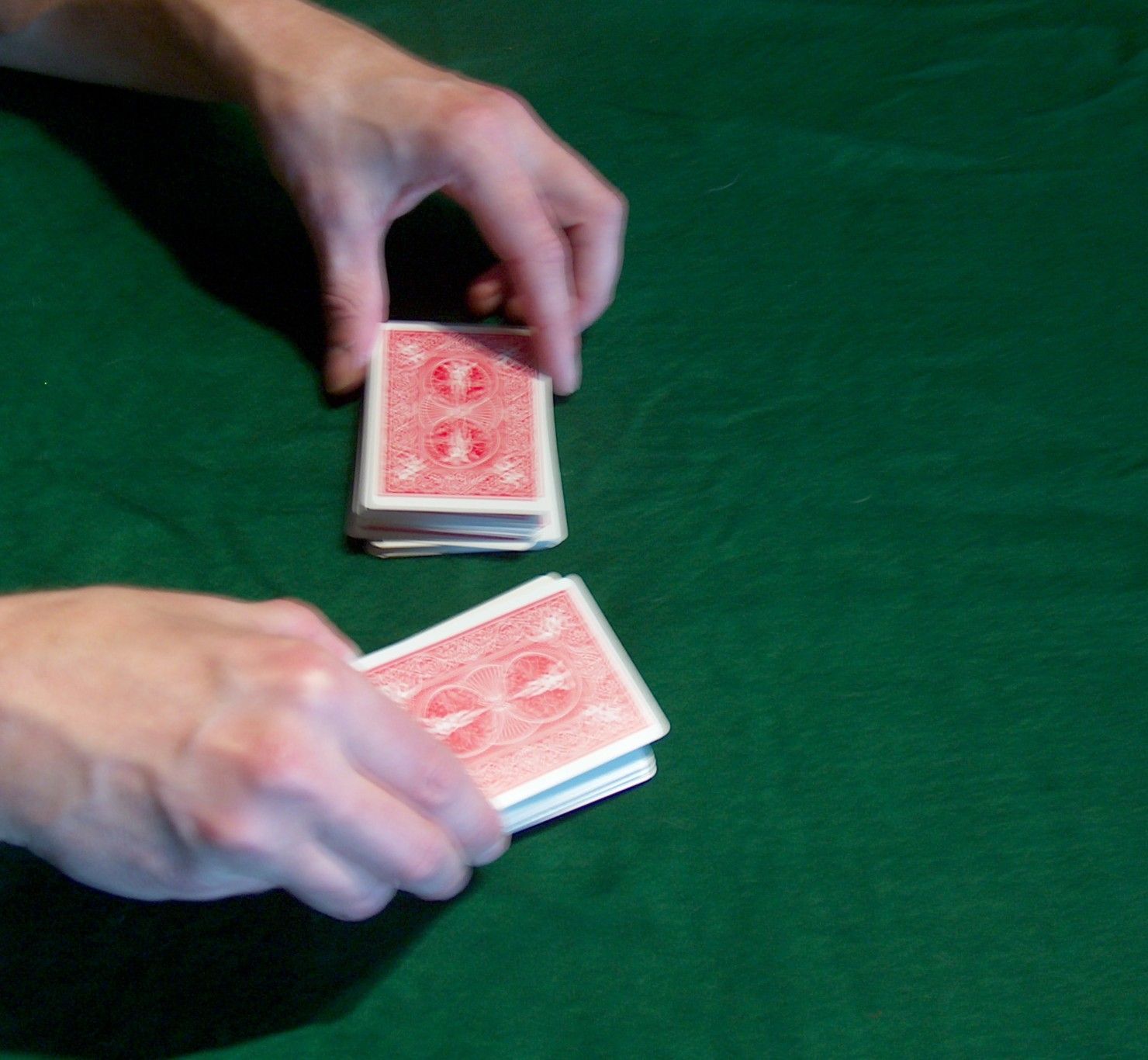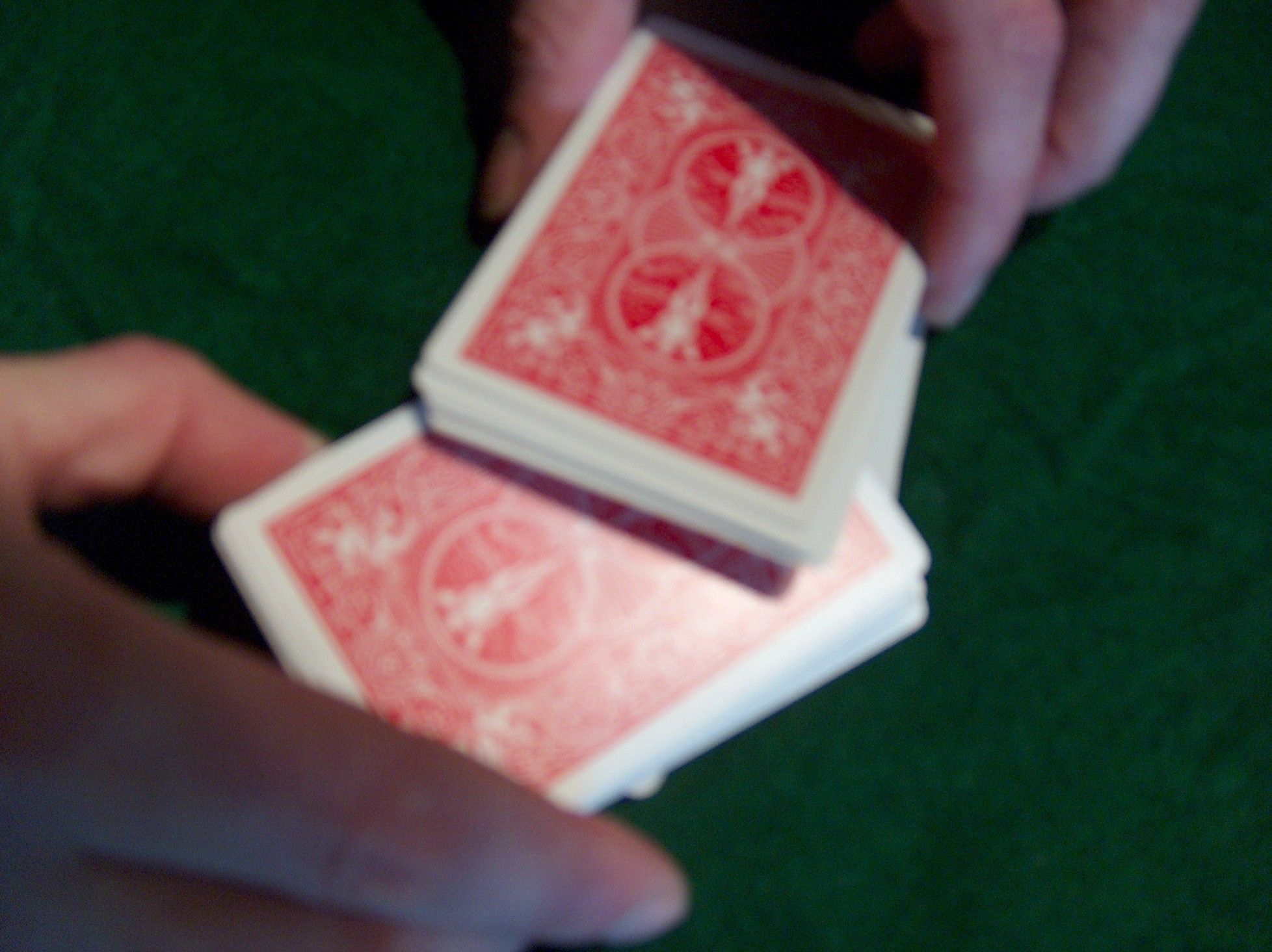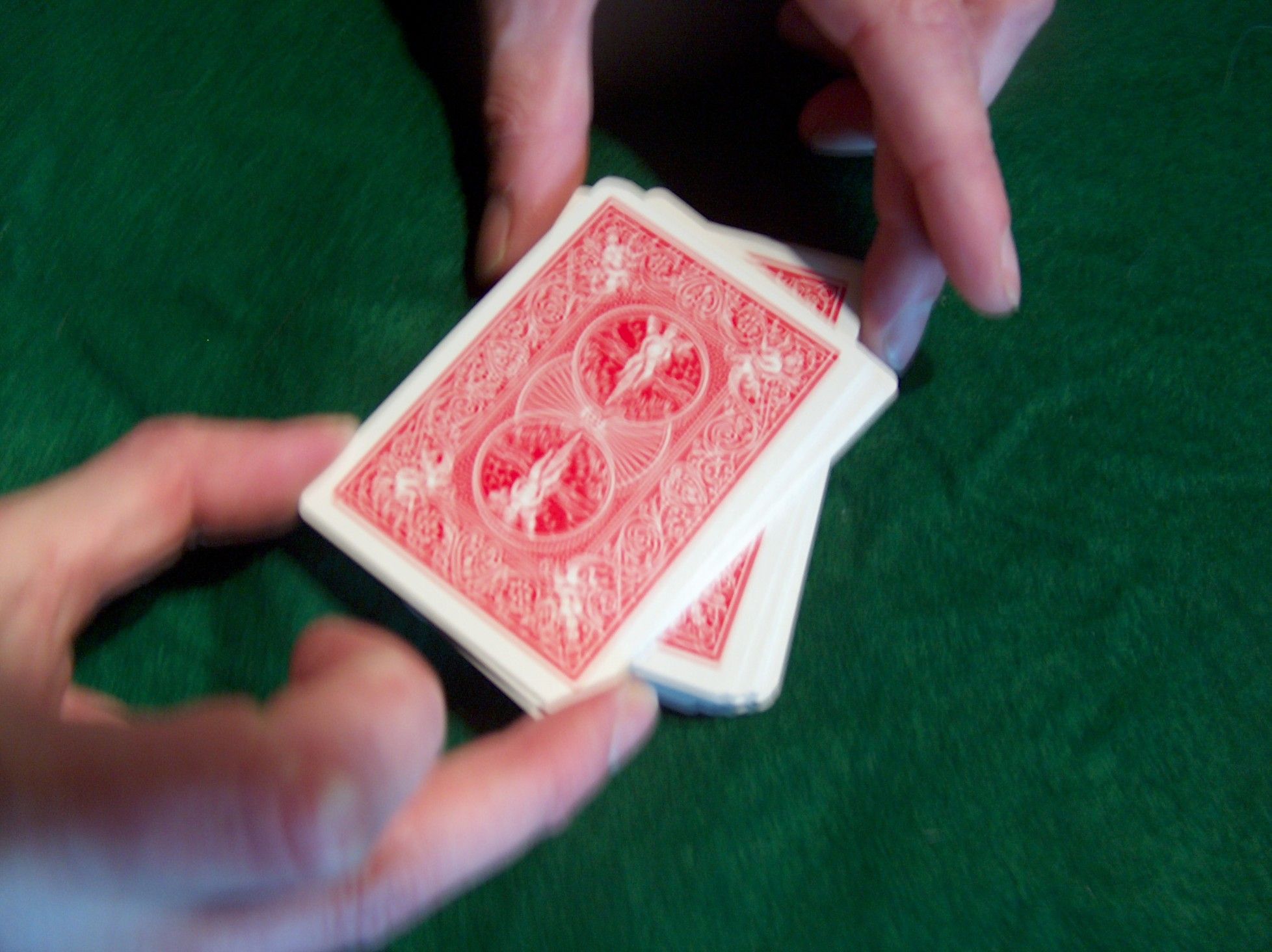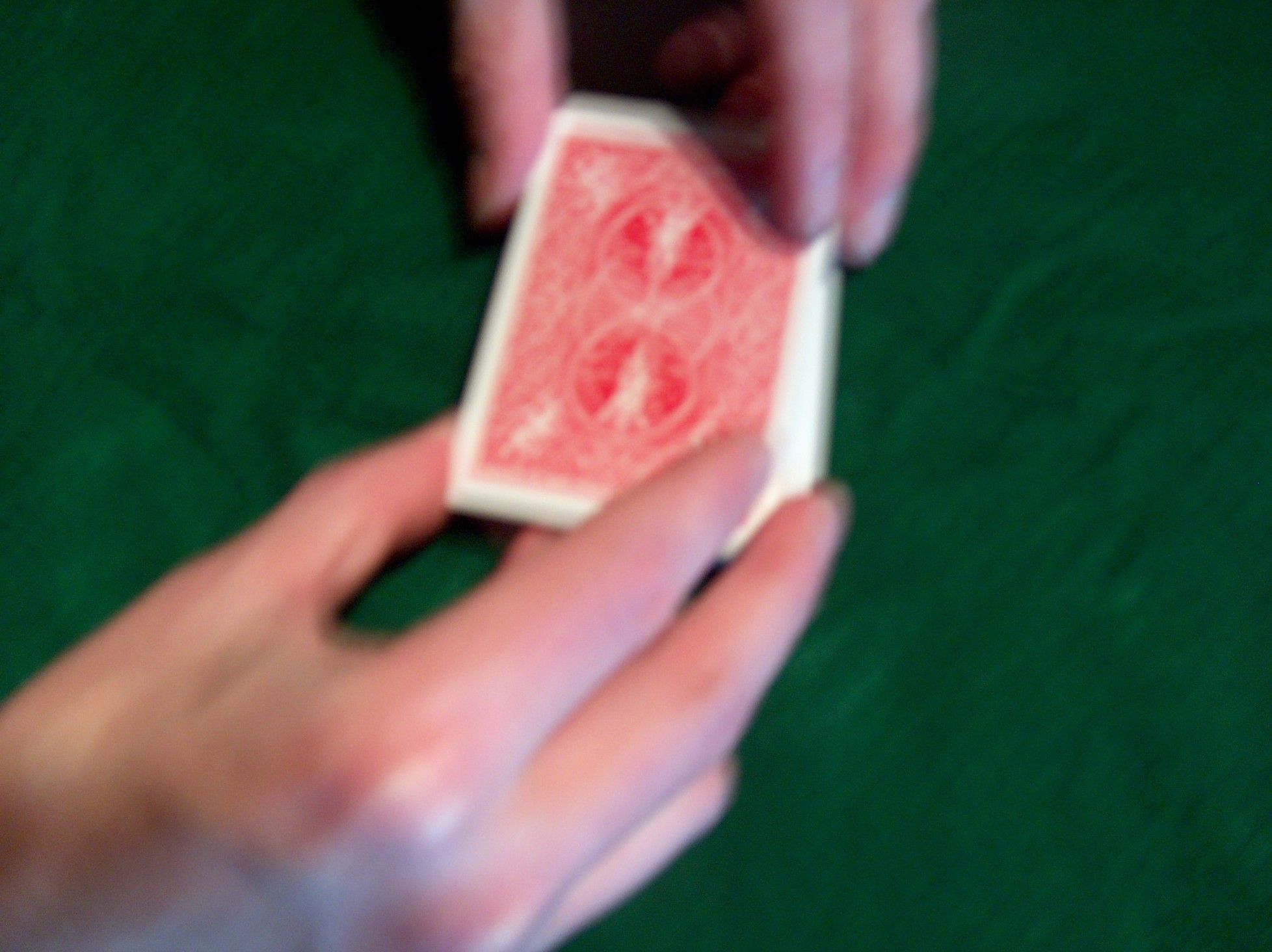How to Shuffle the Deck
Shuffling the cards is an essential part of every game of cards. Shuffling ensures that the deck is mixed and randomized and none of the players is able to determine the positioning or ordering of any of the cards in the deck.
There are a number of different shuffling techniques that will be found at card tables around the world. Some of the most common methods and how to perform them are described below.
NOTE: The shuffling steps described below and the accompanying images for the shuffles detail the standard steps which are usually done with a primarily dominant right hand. However, these shuffle can also be performed in a "left-handed" version. The shuffler would simply reverse the hand positioning used in each shuffle, swapping the use of the left and right hands in each step. In addition, the series of images shown prior to the detailed listing of steps correspond to these steps, although each numbered step may be represented by more than one image.
The Overhand Shuffle: This is probably the most common shuffle found in card games played throughout the world. Although a fairly easy and simple shuffle to perform, this method does an adequate job of randomizing and mixing the deck. The steps detailed below to perform the shuffle should be repeated several times in order to ensure a thorough randomization of the deck.
To perform the Overhand Shuffle:
- Hold the deck of cards in the left hand, with the deck on its edge leaning the deck against the four fingers of that hand. Make an effort to keep the face of the back card concealed by the fingers (keeping the fingers firmly closed) to prevent any player (including yourself) from seeing its rank and suit. Rest the thumb of the same hand gently on the front of the deck.
- With the right hand, grip (using the first two fingers to hold one side of the packet and the thumb on the other) a large packet from the back of the deck which is being held in the left hand. Generally this packet should be larger than half of the full deck.
- After this larger portion of the deck has been lifted, move the right hand thumb out of way and bring this pulled off packet forward, in front of and slightly above the portion that remains in the right hand.
- Bring the packet held in the left hand down slightly and allow the front portion of the packet being held by the left hand to slide down onto the card stack still held in the right hand.
- Again, slightly lower the packet held in the left hand, allowing a small stack to slide onto the growing packet held in the right hand.
- Repeat this last motion until you have just a small portion of the packet left in the left hand. Drop this small packet into the right hand which would then be holding the entire deck.
- This action should be repeated a large number of times to ensure a thorough mixing of the deck.
- When complete square up the deck after which it will then be ready for the deal.
The Riffle Shuffle: This is also a common shuffling method and is very good at getting the cards quickly and thoroughly mixed. There are two normally used methods of performing the riffle shuffle. The first method described is done flat on the table. Below this method is described the steps for performing the shuffle completely in the hands, without the use of the card table to support the deck. While the in hand method is somewhat showier, performing the shuffle directly on the table is better at ensuring no player gets a glimpse of the face of any card.
The following steps show how to perform the Riffle Shuffle (on the surface of the card table):
- Begin by laying the complete deck on the surface of the table gripping it with the left hand. Slide off approximately one half of the deck with the right hand, placing it directly to the right of the first packet still held by the left hand.
- Make an effort to ensure that no players, including the one shuffling, is able to catch a glimpse of the face of the card at the bottom of either packet.
- Place both of the halves face down on the table opposite each other slightly apart.
- Holding down the main part of each packet with the backs of the first and second fingers, one hand per packet, bend up the ends of the packets closest to each other with your thumbs.
- As the cards begin to fall back down after the thumb passes, slide the two deck halves closer together such that the falling cards interlock.
- Allow the riffle to continue as the cards will fall down interlocked and intermingled.
- Once all the cards have riffled down, release the pressure on the fingers holding the backs of the cards.
- Keeping the cards on the table, slide the two halves inward together and square he deck, leaving them in their mixed order.
- You will probably want to repeat this shuffle 3 or 4 times to ensure a very thorough mixing from the original order of the cards.
- Once completed the deck is then ready to be dealt.
Alternatively, at the completion of the shuffling motion, instead of simply sliding the two halves of the deck together, they can be arched upwards with both hands to cause the cards to cascade downwards together to form the complete deck.
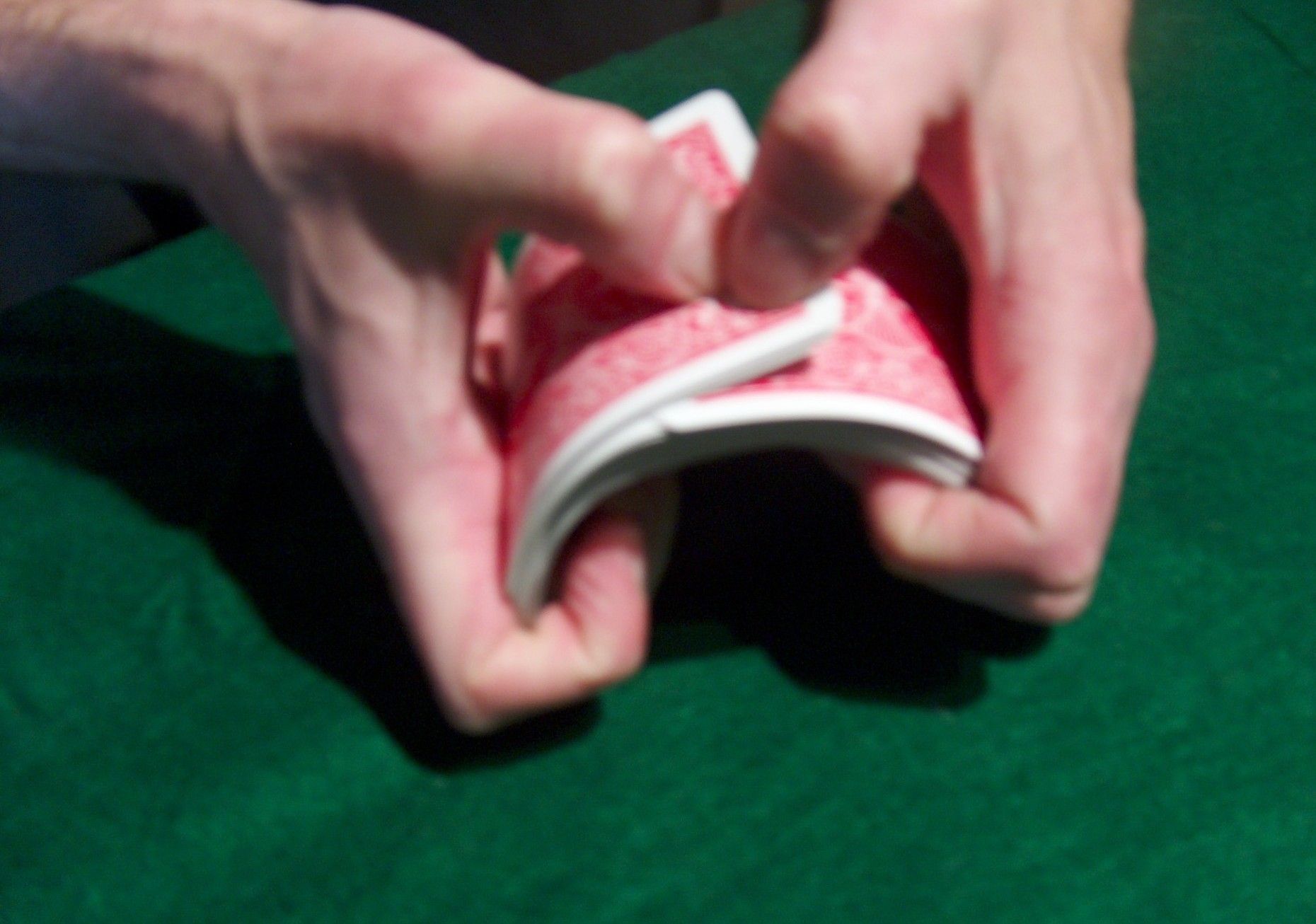 |
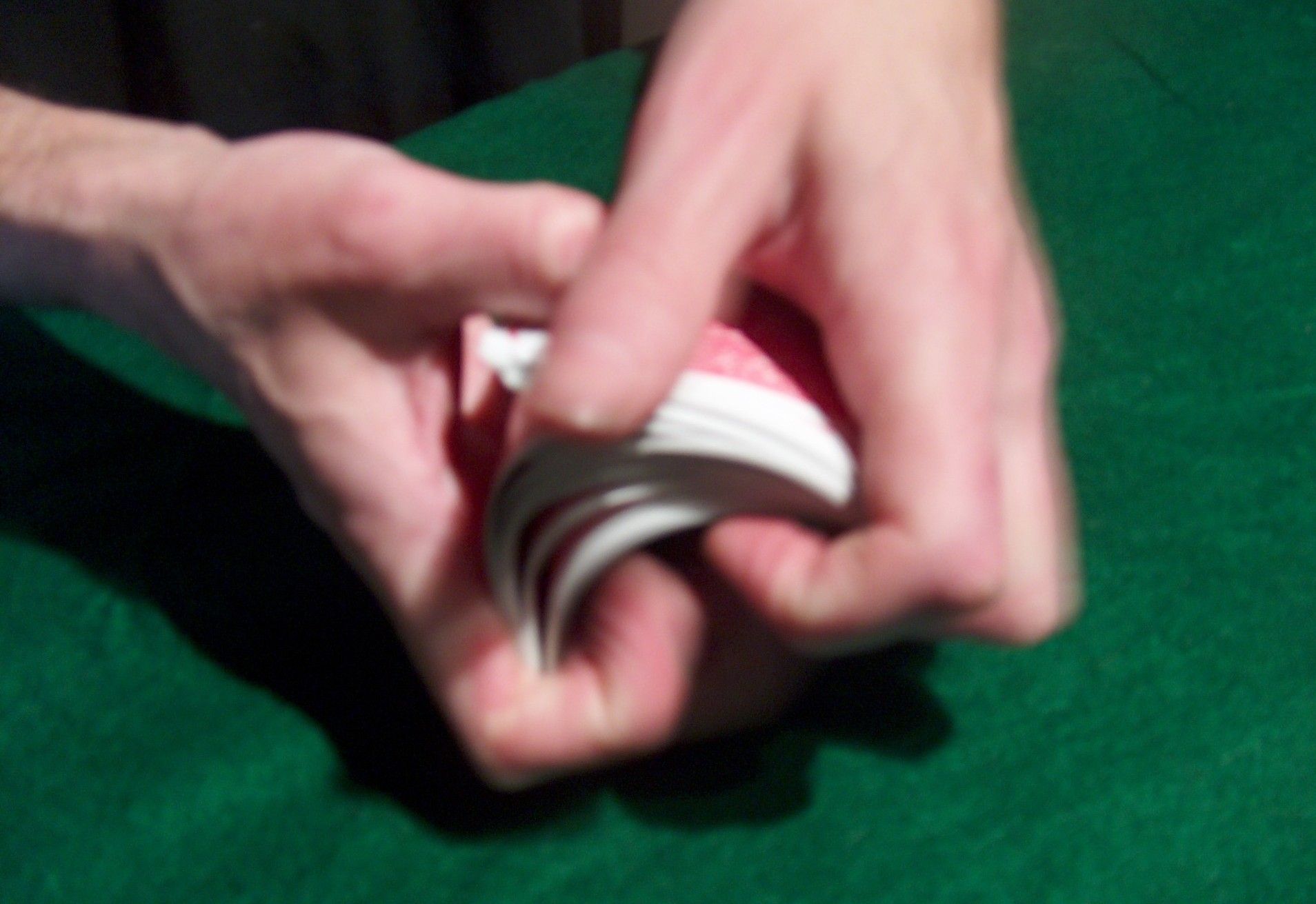 |
The next steps show how to perform the Riffle Shuffle completely in the hands, without using the card table. This is slightly more difficult than when performed directly on the table.
- Take a full squared deck of cards and divide it into two halves of close to equal size.
using the thumb on the upper edge of the deck and the middle and ring fingers of each hand to grip and pull the halves of the deck apart.
- As before ensure no player is able to view the face of any card during the shuffle. This is slightly more difficult since the cards are suspended in the air by the hands vice blocked by the surface of the card table.
- Grip each packet, held face down, such that each packet is held in one hand. Each packet should be gripped in such a way that the thumb is hold one side (the side of the deck closest to the other hand) and the other fingers curl around the bottom of the other side of the deck.
- The fingers continue to hold the packet to prevent it from dropping out of each hand and the thumbs tightly holding the other end. The two halves of the deck should then be tilted up to an almost vertical position with the faces of the cards in both packets facing inwards towards each other.
- The two halves are then brought close together and the bottoms of the packets are then moved as if to align the two halves in a horizontal direction. However, the thumbs should retain their position with firm pressure from the thumb applied to the deck. As the deck is partially arched downward, the two halves should slowly riffle down past the thumb, with the packets gently falling together still supported by the remaining fingers of each hand.
- The cards should be held solidly by the fingers, which will ensure the cards are held steadily as they are riffle together.
- After the deck has fully riffled together, the deck can either be pushed together to square it up, or, as in the table version can be allowed to cascade downward to reform the deck. To perform the cascade finish, bend the cards towards each other and then remove the pressure from the grip of the thumbs to allow the cards to cascade back into the full deck.
The table Riffle shuffle will sometimes be performed in which the cards are held in such a manner that only the corners of the cards actually are in contact. The shuffle is performed the same way as described above, with the deck placed such that the cards are only riffling together at one corner of the deck. This is done as it causes slightly less wear on the cards.
The Weave Shuffle: The Weave shuffle is an easy shuffle to accomplish and essentially consists of sliding two halves of the deck in to each other in such a manner that they weave together combining the intermingled cards from both piles into one pile in the process.
The following steps detail how to perform this shuffling method:
- Hold the deck, squared, in your left hand. The left hand should then pull a stack of cards from the deck which contains about half the cards. The goal in this step is to get these packets to be as close to the same size as possible for best results from the Weave shuffle.
- Each hand should then hold one of the two packets, with an effort made to conceal the bottom card of each packet from being viewed by any player.
- Ensure each half is firmly squared up in each hand.
- Keeping the packets held in the same orientation, bring the packet in the left hand directly on top of the packet held in the right hand. Retain the lower stack, held in the right hand, with a somewhat loose grip.
- Slide the top packet downward into the bottom packet, in effect weaving the two packets together. To begin the weave, it is often necessary to slide the top packet in a slight horizontal motion across the top of the bottom packet.
- Once the packets have interlocked and begun the weave, snugly slide the top packet down into the bottom packet to reform the full deck, which will end up in the right hand.
- Firmly square up the deck, continuing to hold it in the right hand.
- These steps can be repeated multiple times in order to ensure a thorough shuffle is accomplished.
Some shufflers find it simpler and faster to begin to slide the two halves together from the corners rather than straight at the top. Either way ends in the same result, so use whatever works best for you.
This shuffle should not be done too forcibly, as doing this shuffle roughly will tend to make the cards harder to weave and can damage the cards used during the shuffle. Also, this shuffle should not be performed on already damaged playing cards as it will further damage the cards and complicates the performance of this shuffle.
The Hindu Shuffle: The Hindu Shuffle is another common shuffle, somewhat similar in concept and result to the overhand shuffle.
The following steps can be used to perform this shuffling technique:
- Hold the deck in the left hand, gripping the deck from the two longer edges using the thumb on one side and the forefinger on the other.
- Bring the right hand underneath the deck and grab the lengthwise sides of the deck gently with the right thumb, middle and ring finger.
- Slide this right hand away from the deck, retaining the grip on a small packet from the top of the deck in order to pull this small packet of cards from the top of the full deck still held in the left hand.
- Keep the index finger of this right hand extended outward. This prevents any cards from sliding forward out of the right hand as the packet is pulled away.
- When the right hand completely pulls the packet off the top of the deck held by the left hand, the cards should fall into the palm of the right hand.
- The right hand, how holding this first small packet of cards, now slides under the deck again repeating the gripping of the deck with the thumb, middle and ring fingers.
- In the same manner the right hand is again slid out from under the deck taking another small packet of cards from the top of the deck and allowing them to fall down onto the packet pulled off the deck previously.
- This should be continued until all but a small packets of cards are left in the left hand.
- This last small packet should then be placed on top of the stack in the right hand and the deck squared up for dealing or, for a more thorough mixing this shuffle can be repeated several times.
The Wash Shuffle: This shuffle is also known by a number of other names such as the Irish shuffle, Beginner shuffle and The Scramble. It is probably one of the easiest shuffles to perform and is often used by beginners.
Because a newly opened deck of cards is packed in a highly ordered manner by denomination and suit, the Wash shuffle is often done when opening such a deck of cards for the first time.
This shuffle can be done using the following steps:
- The entire deck of cards should be laid in a stack on the table and then spread out in a fan formation, with all the cards still remaining face down.
- The cards are then slid around vigorously and thoroughly on the table with both hands to ensure they are well scrambled from their previous ordered positioning. The cards as they are slid around by the hands, should go over and under each other as they are slid around, intermingling on the table. This action should be continued for at least one minute, using both hands and sliding different cards in a random motion.
- After a thorough mixing in this manner, the cards should then begin to be brought back towards the center, still face down, to re-form the deck which is then squared up and ready for dealing.
This shuffle requires a relatively large amount of room to perform and can take longer than most other shuffling methods. Although it is a very basic and beginner shuffle, it actually does a good job of randomizing the cards.
The Running Cut Shuffle: Also called the Strip shuffle, the running cut shuffle is an easy shuffle to perform and is often performed in conjunction with one of the other shuffle methods, such as the Riffle shuffle.
This shuffle can be accomplished by following these steps:
- Begin with the deck, face down on the table. It should be set with the longer edge of the deck of cards facing the shuffler. With the right hand, place the thumb and forefinger on opposite sides of the back end of the deck gripping it with these two fingers.
- Place the thumb and forefinger of the left hand in a similar position at the opposite end of the deck.
- The thumb and forefinger of the right hand should then grip a small packet of cards from the top of the deck while the left hand slides the remainder of the deck out from under this packet in a forward direction.
- The left hand then brings the packet that was slid out and places it on top of the smaller packet which should now be allowed to fall on the surface of the table but still lightly gripped by the right hand. The right index finger then moves out of the way to allow the packet to be set on top of the deck.
- The packets will normally not be aligned exactly even, and the right hand adjusts to lightly grip this upper packet placed on top of the deck on the surface of the table while also still retaining a grip on the first packet on the table.
- The right hand should tighten its grip somewhat in such a way that it will hold off a portion of the top of the stack on which was just placed on top of the deck. The left hand will then again pull its still held stack out from the main deck again, minus a small packet at the top that the left hand had tightened its grip on.
- The left hand then again places the shrinking stack on the top of the deck which is on the table and the right hand again readjusts its grip to retain a few cards from the top of the stack that was just placed on top.
- This should be repeated until the shrinking stack held in the left hand is reduced to just a few cards which are then placed on the top of the growing stack still held by the right hand on the table.
- This should be repeated a number of times (at least 8) to ensure the deck is adequately mixed.
- Once completed, the deck should be squared and is then ready for the cut and the deal.
Copyright © 2015 CatsAtCards.com. All rights reserved.
